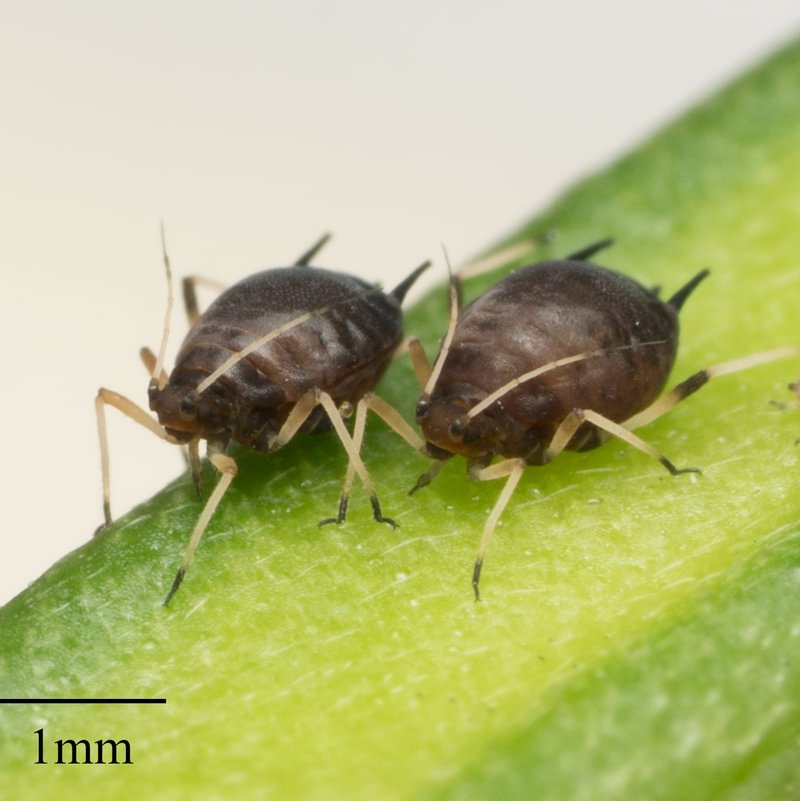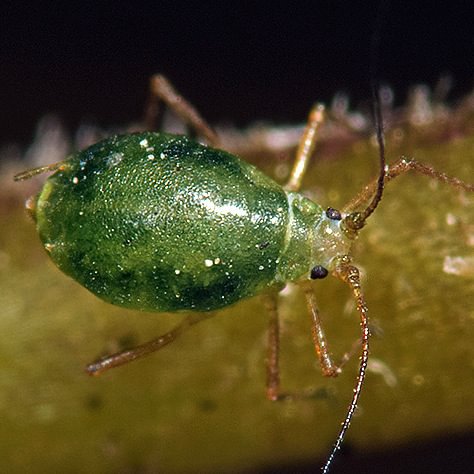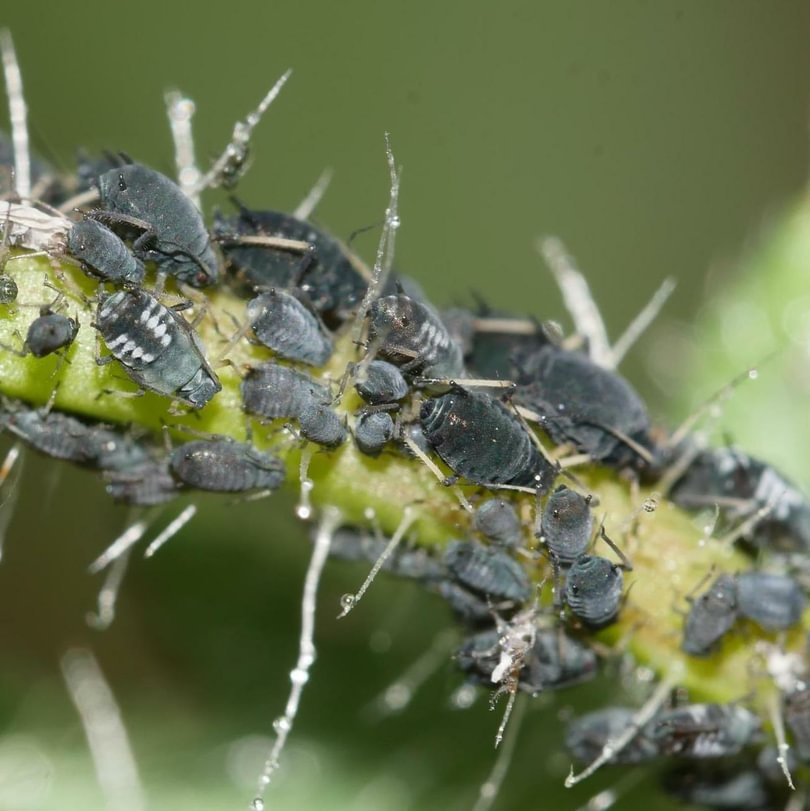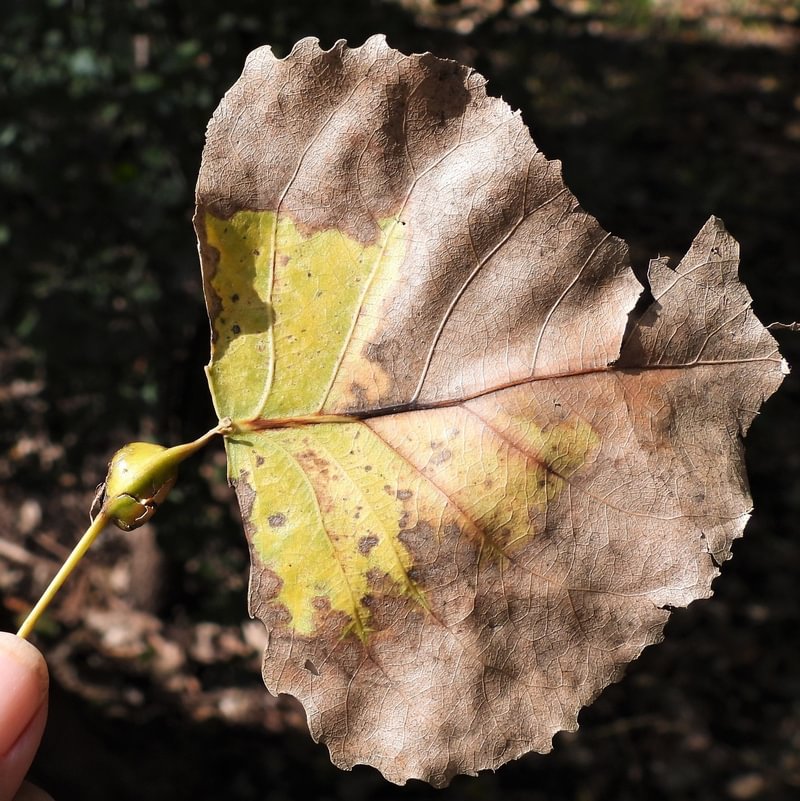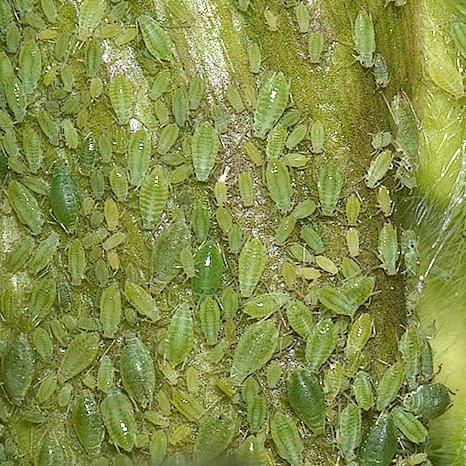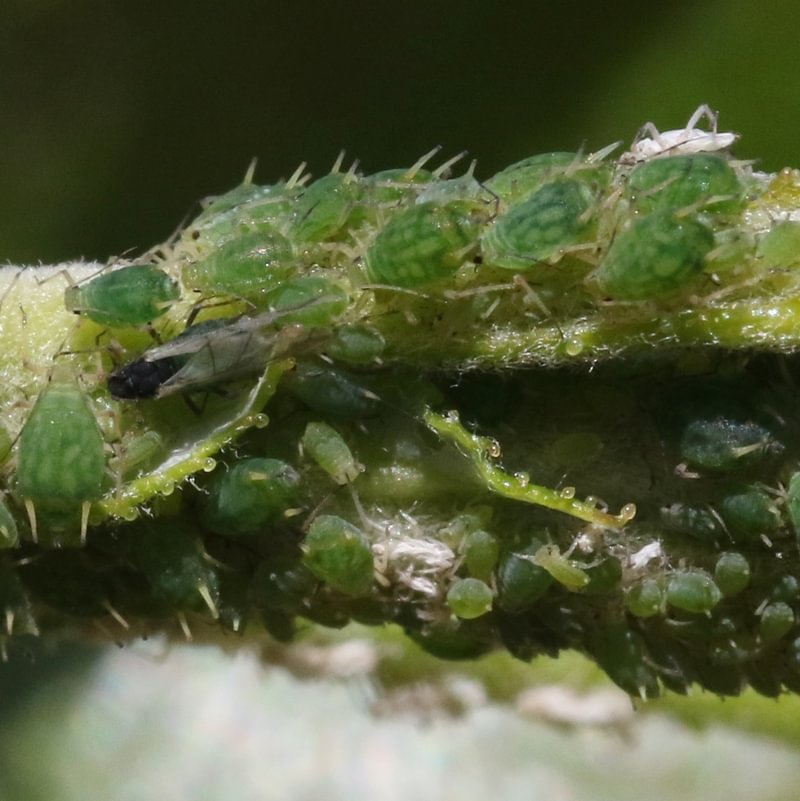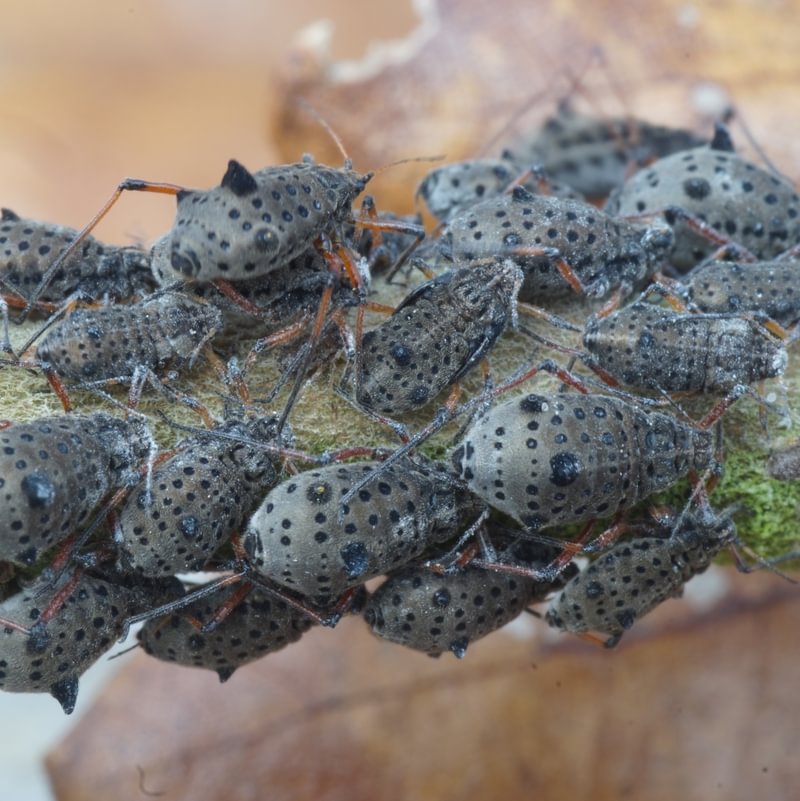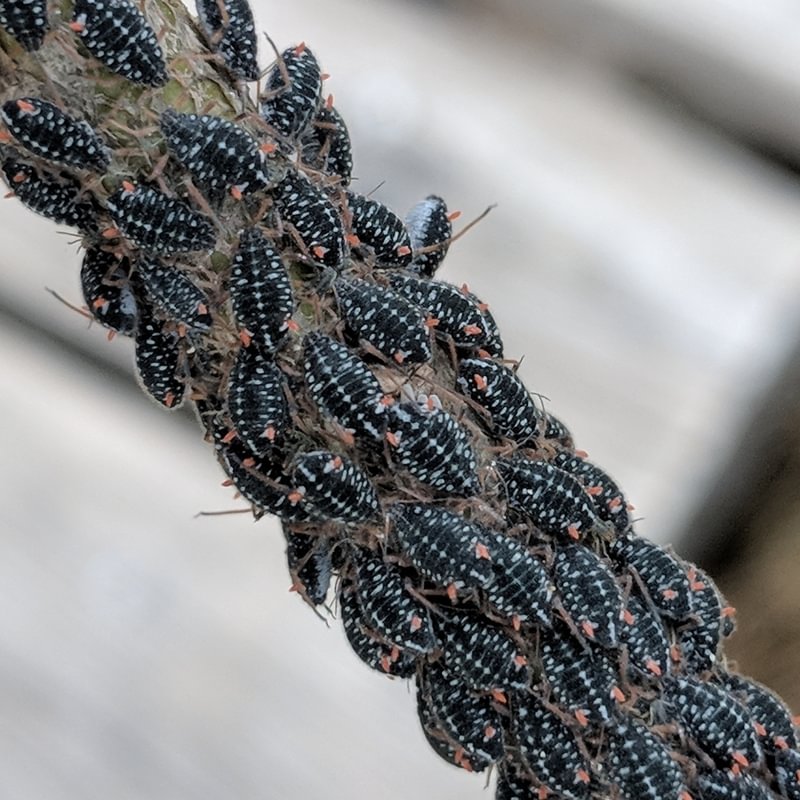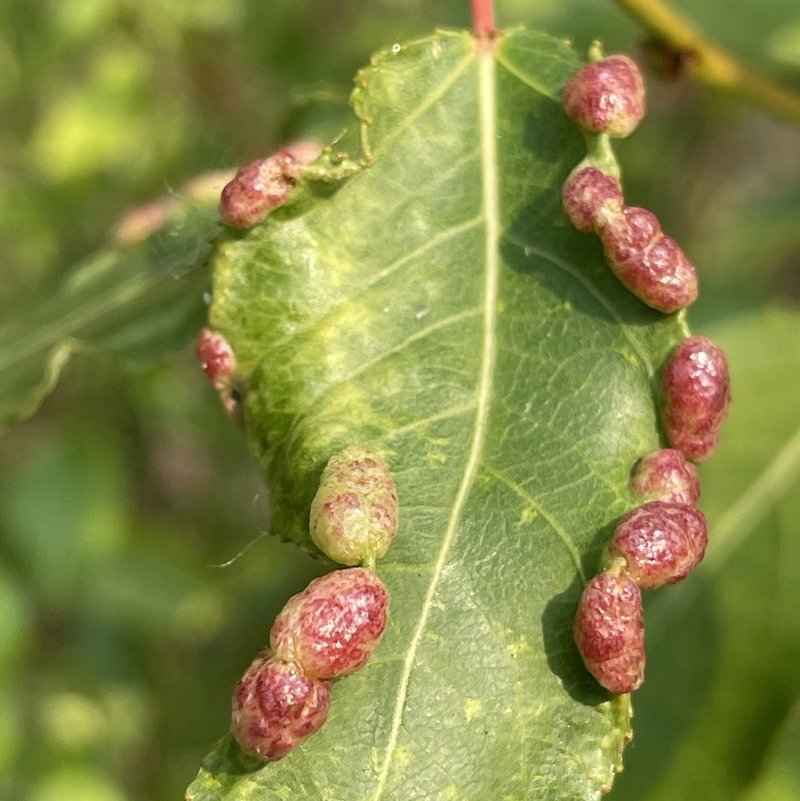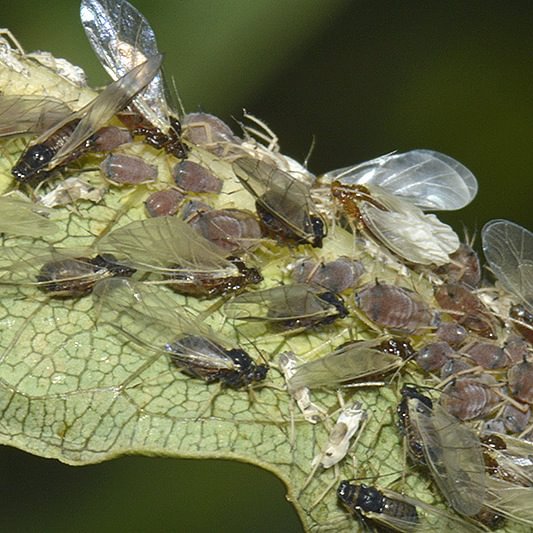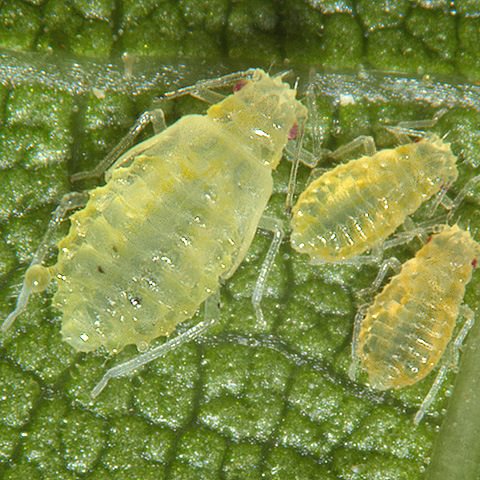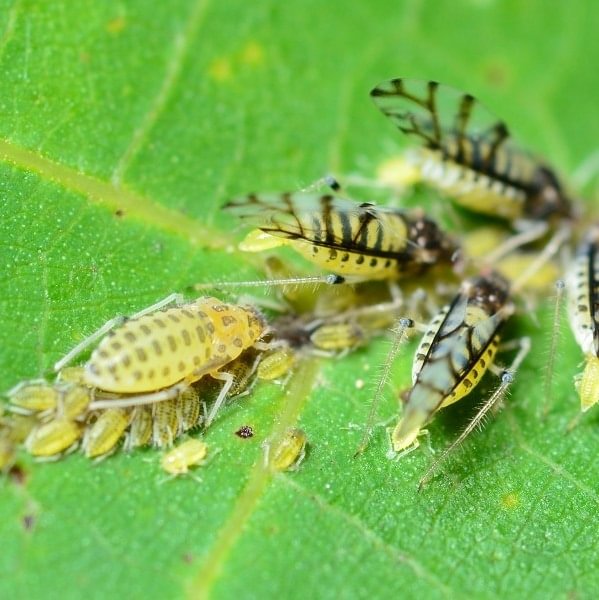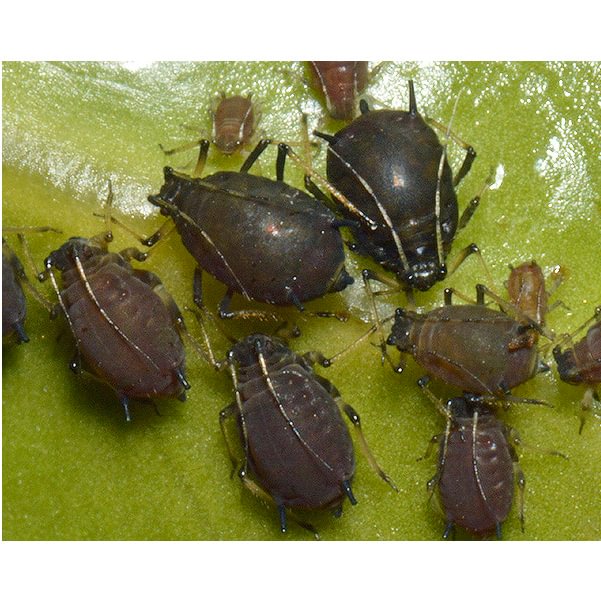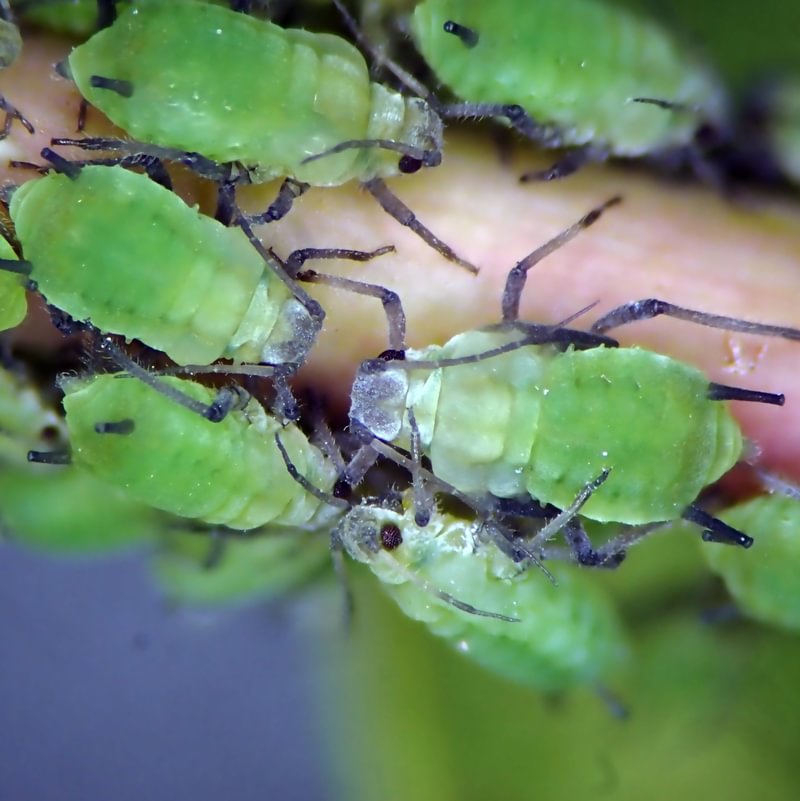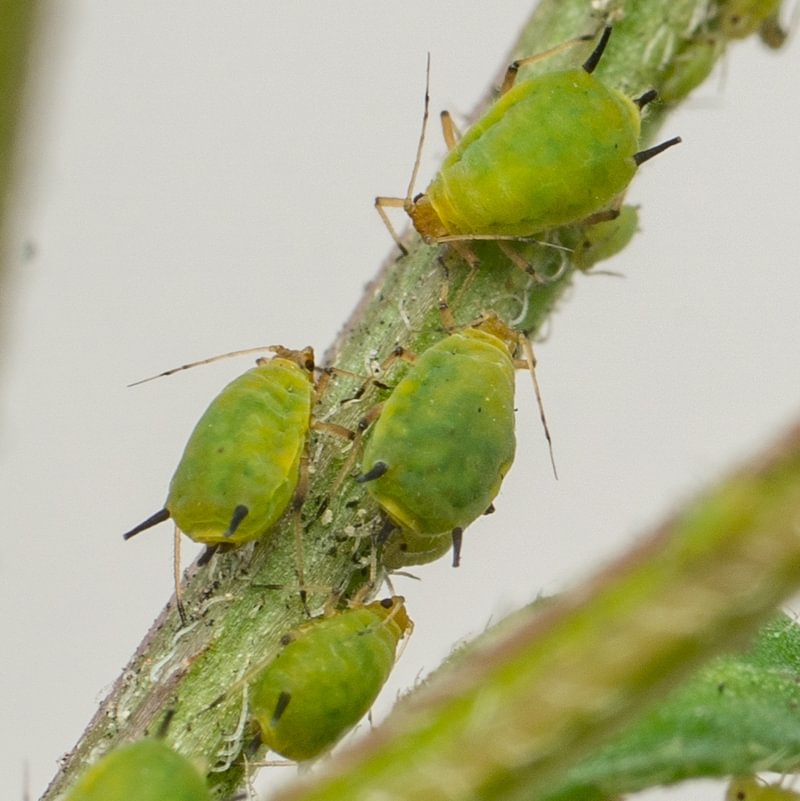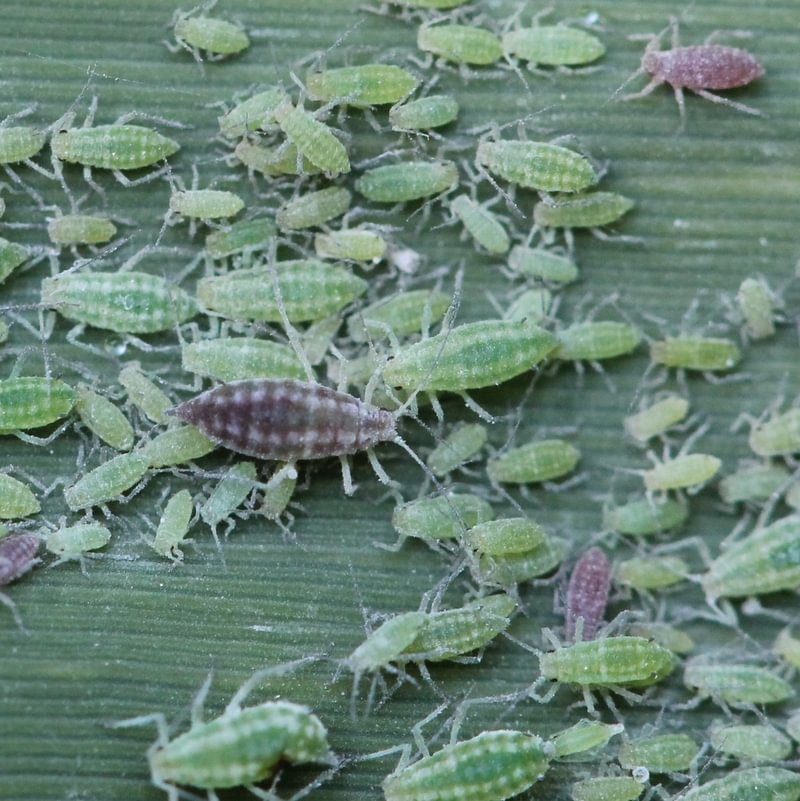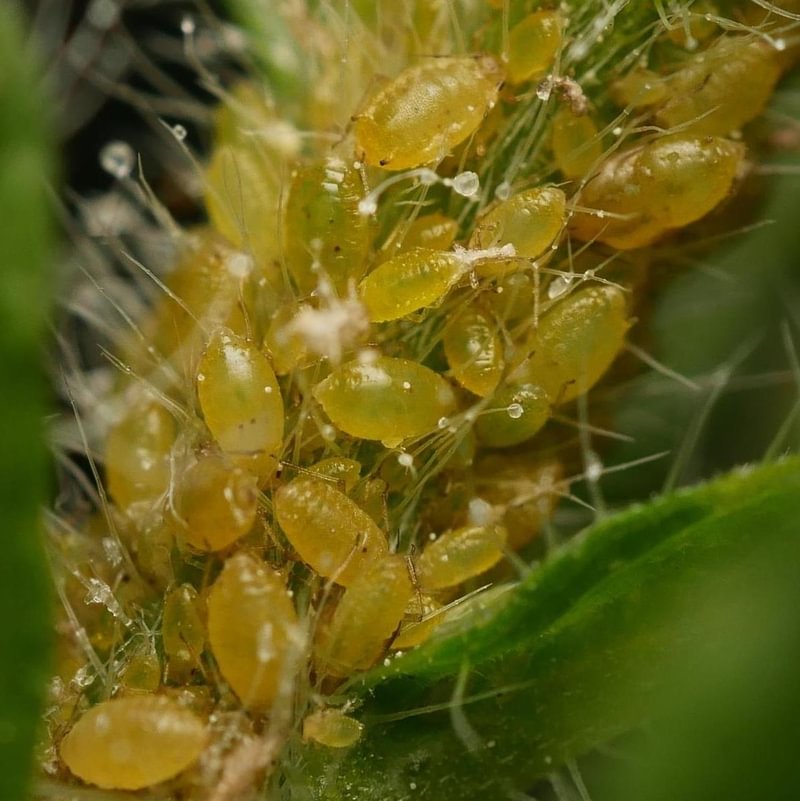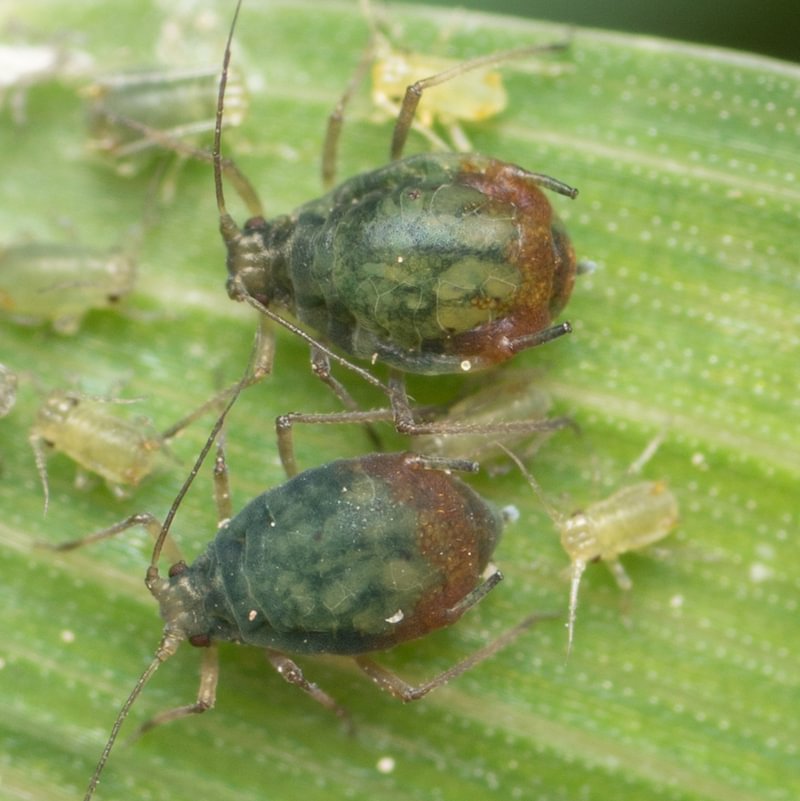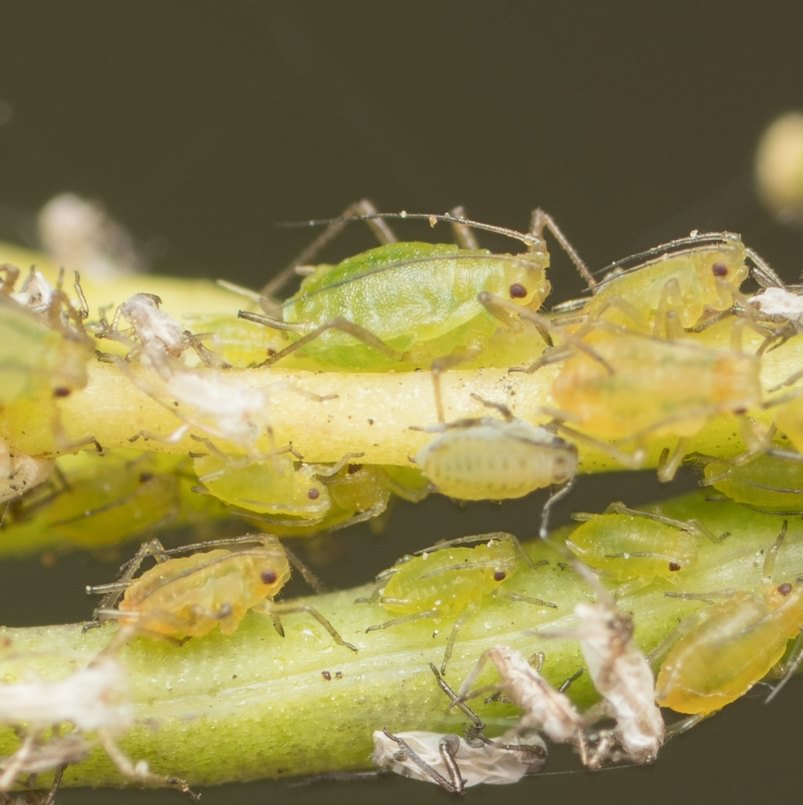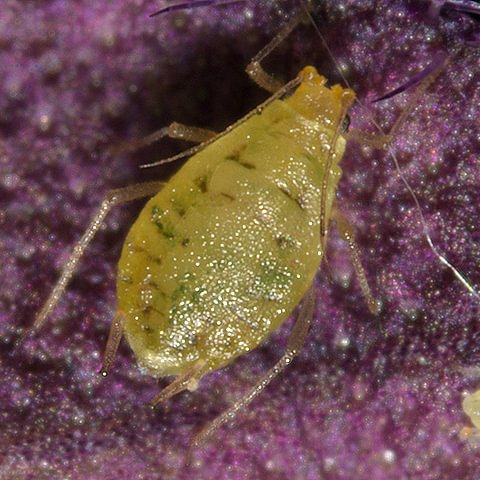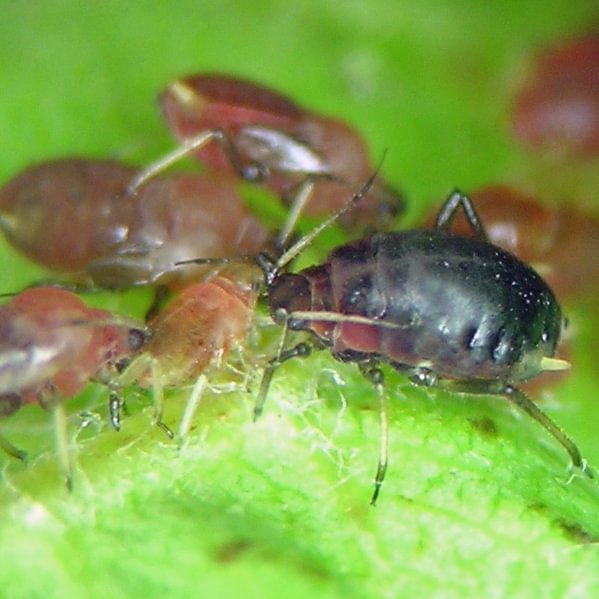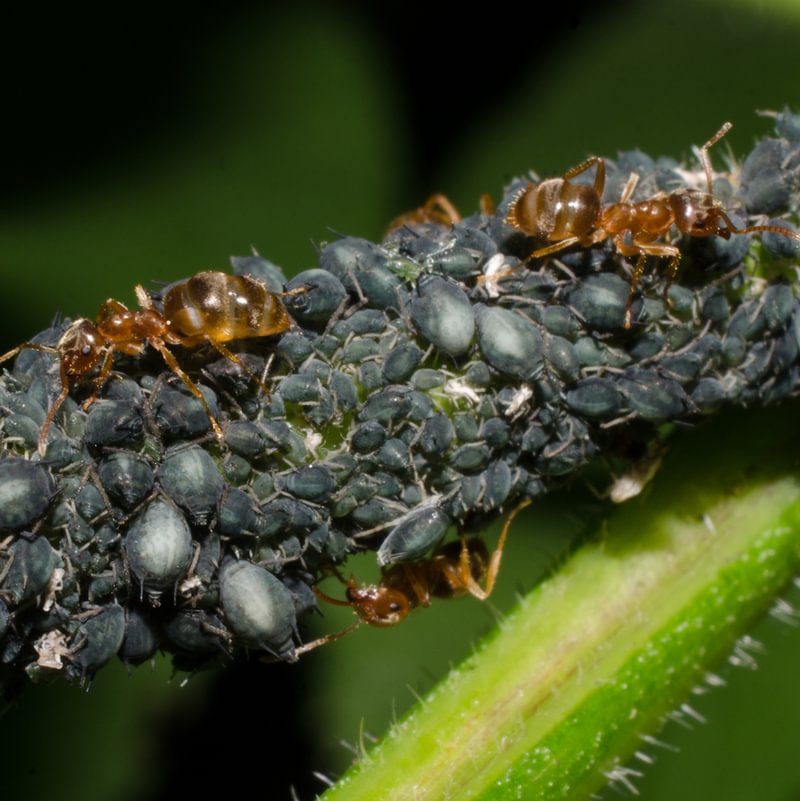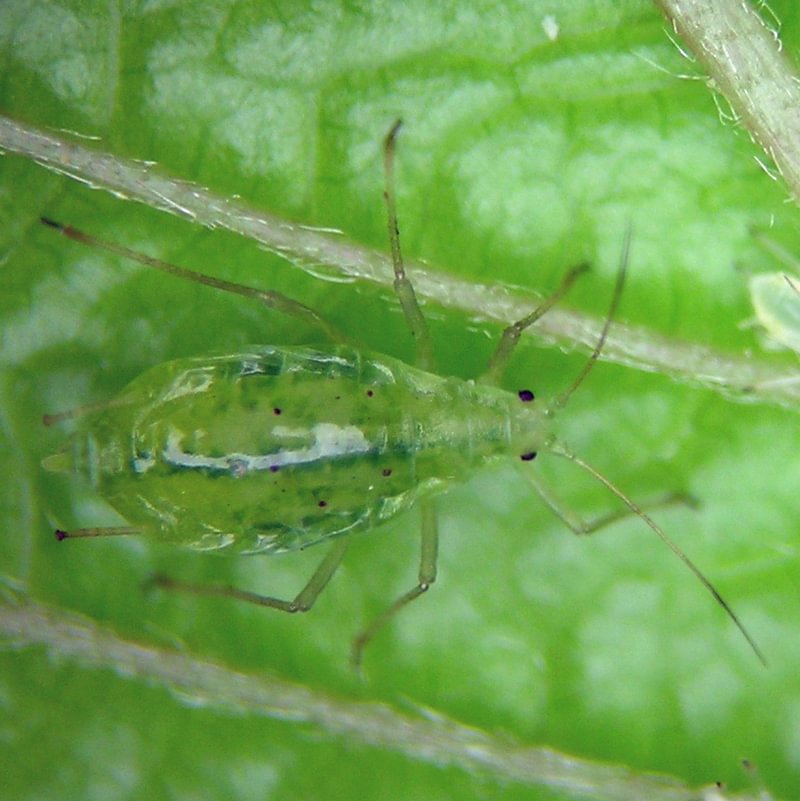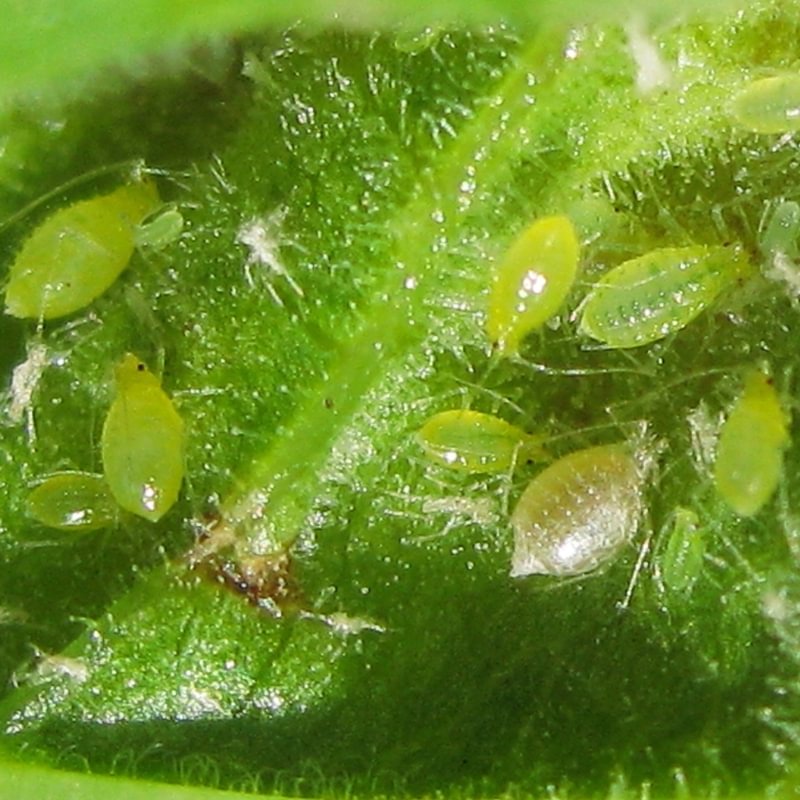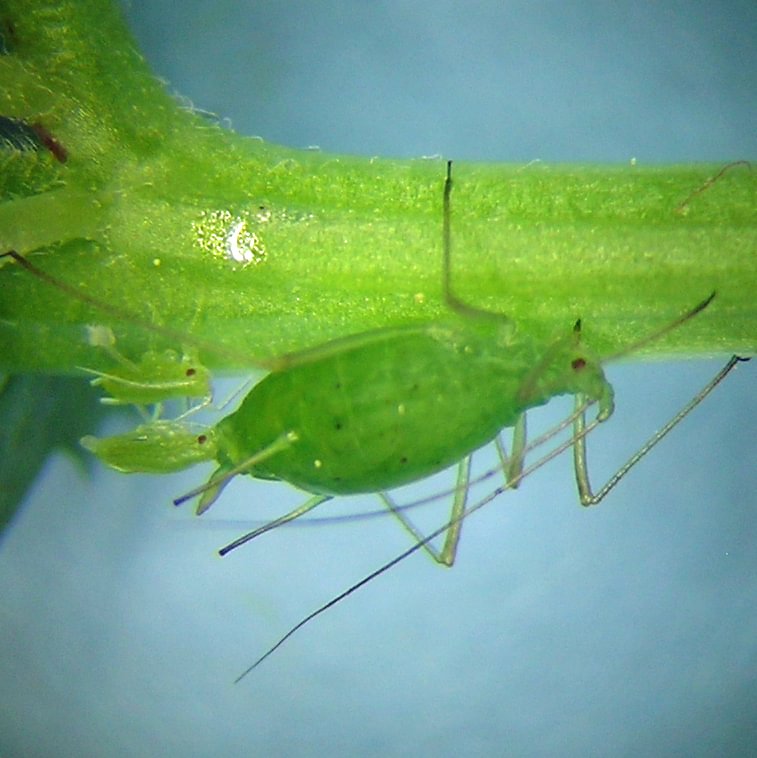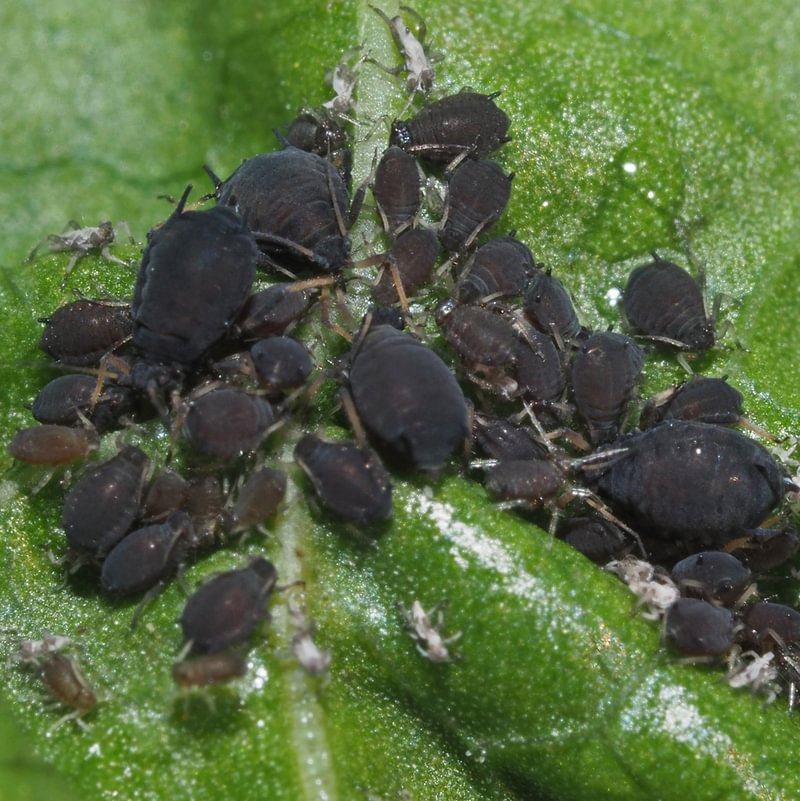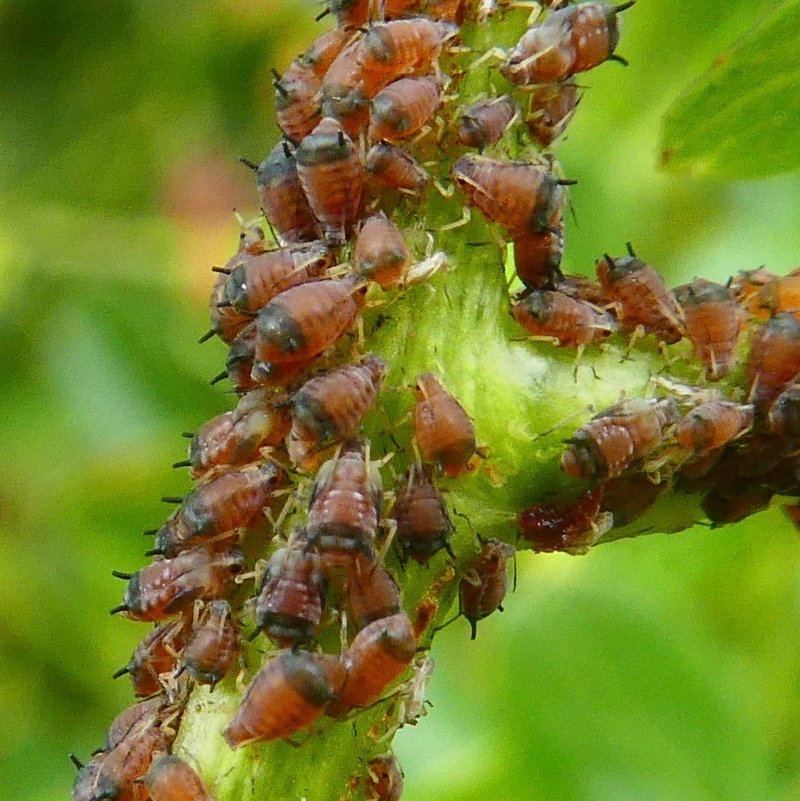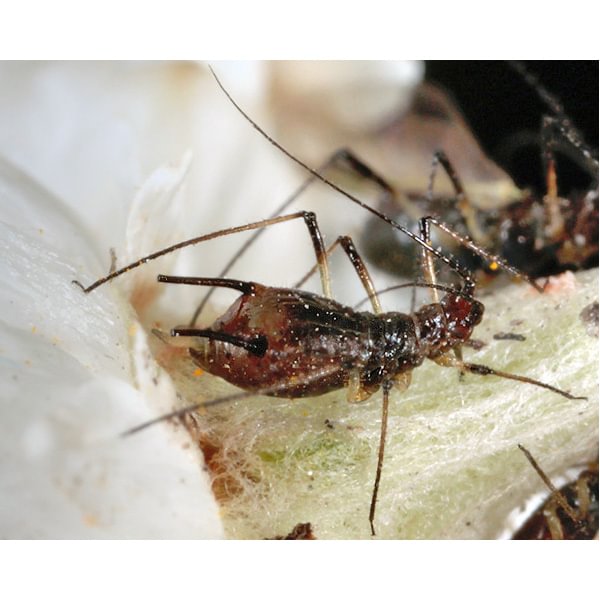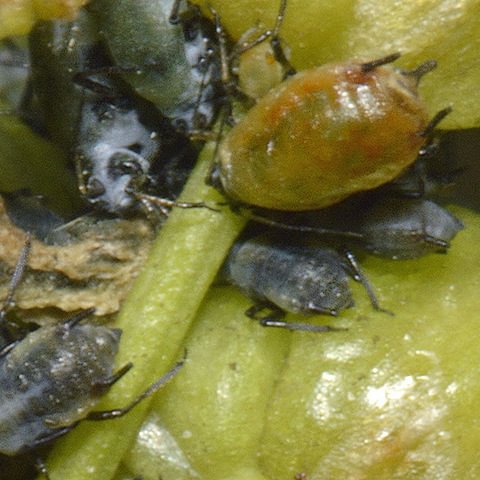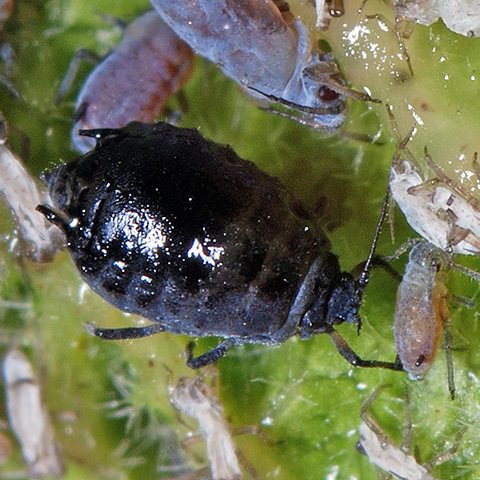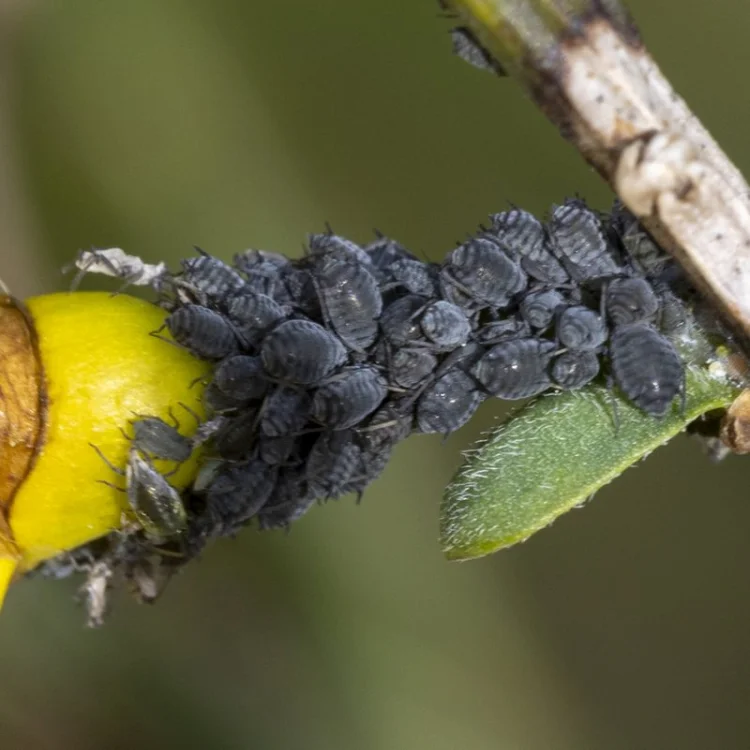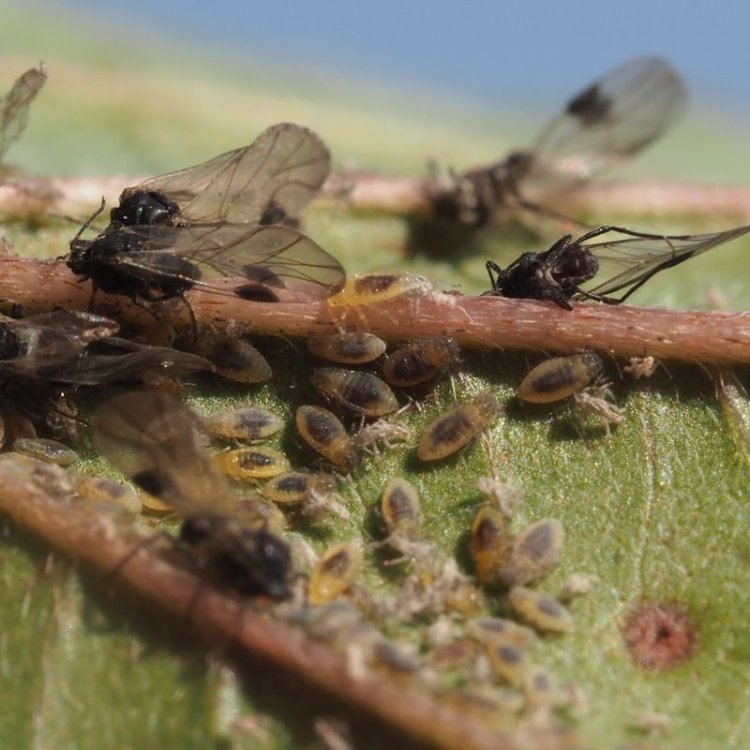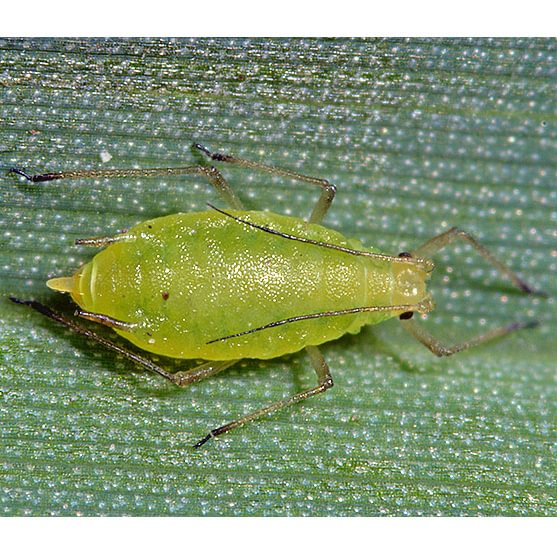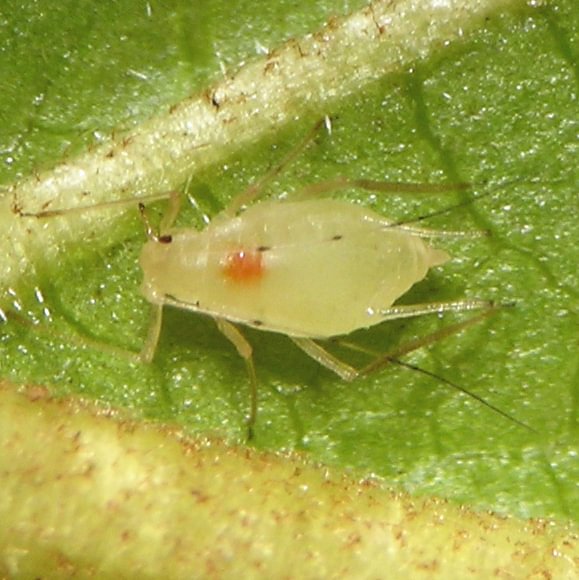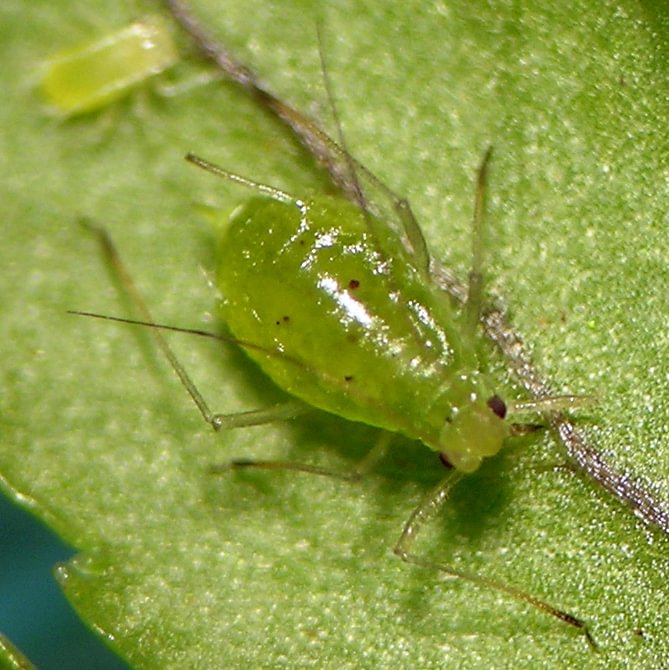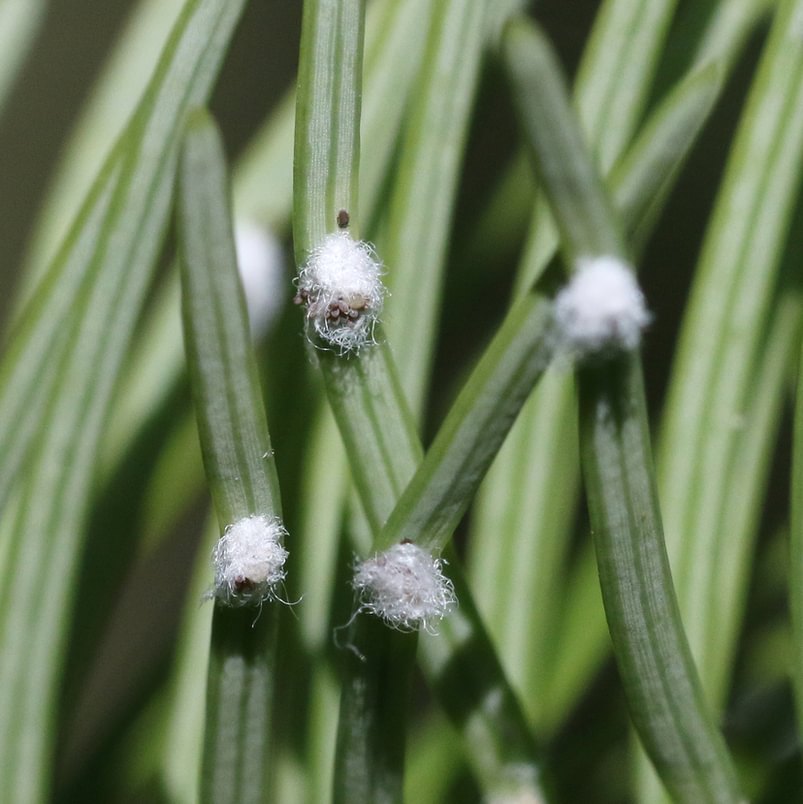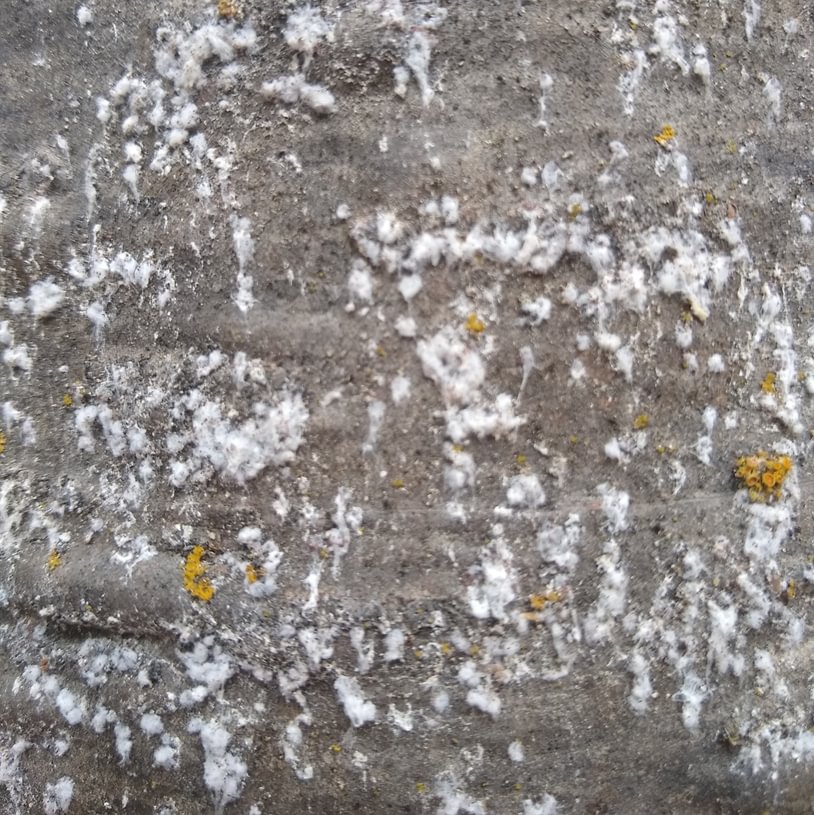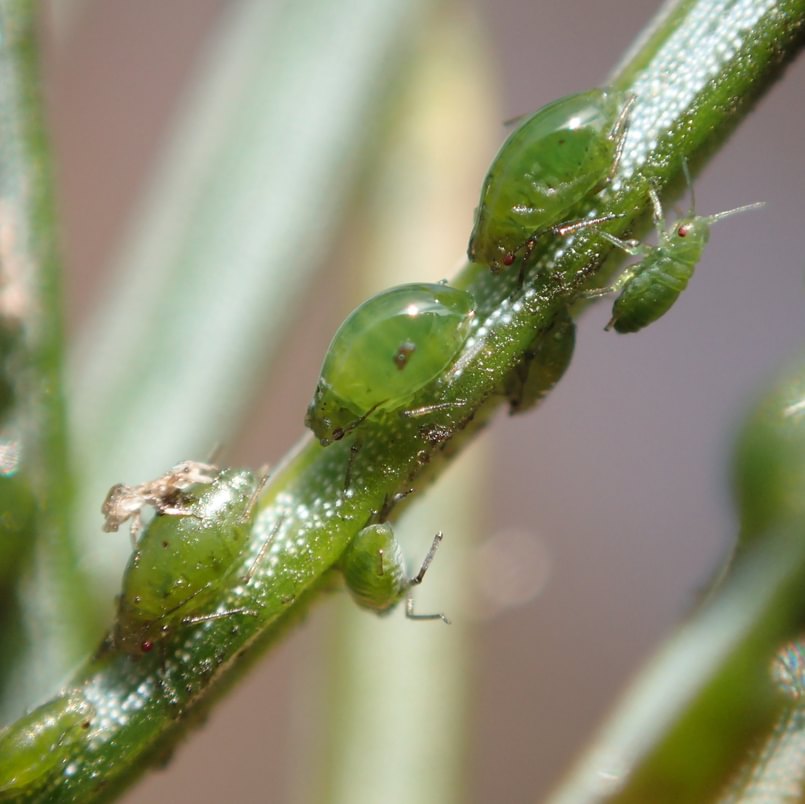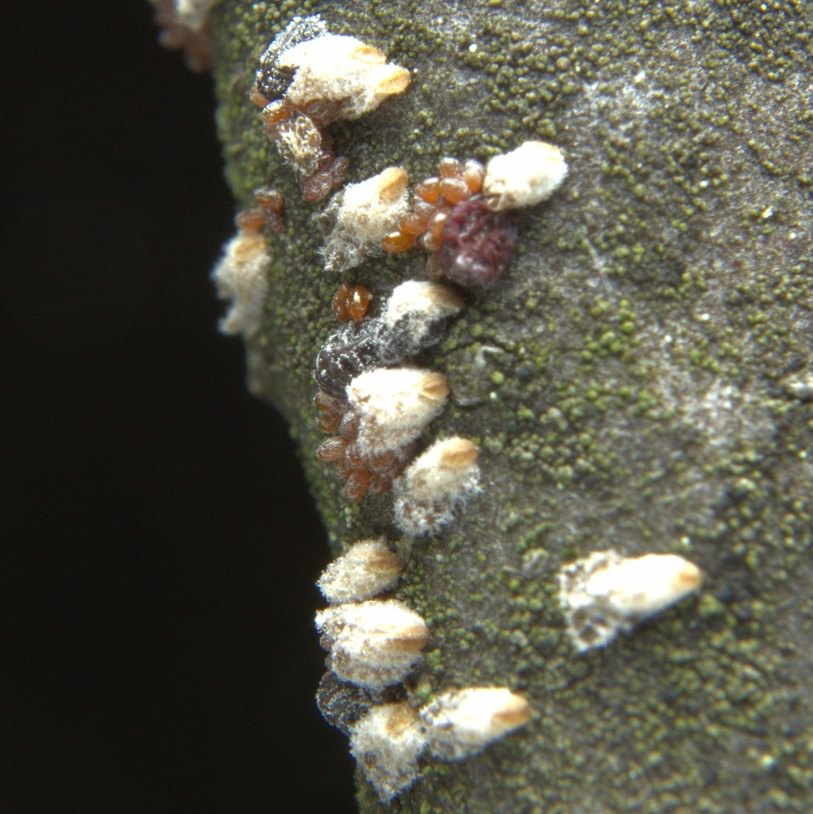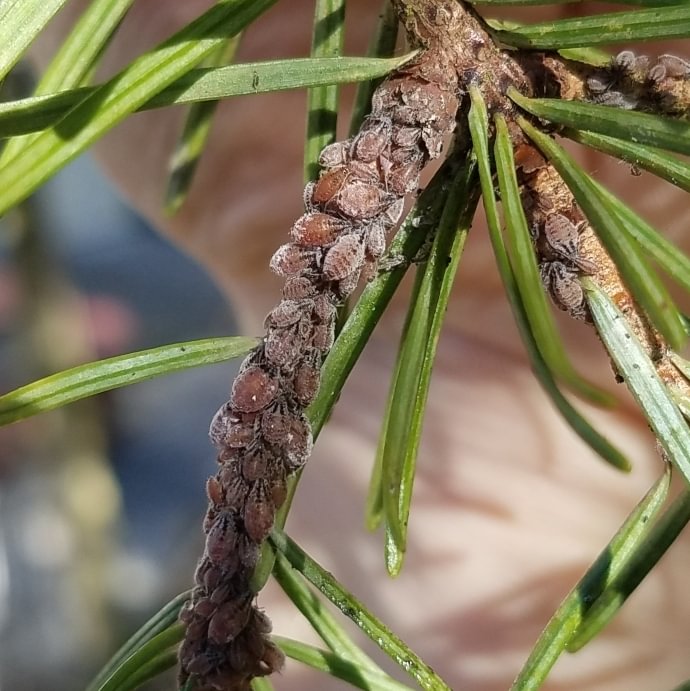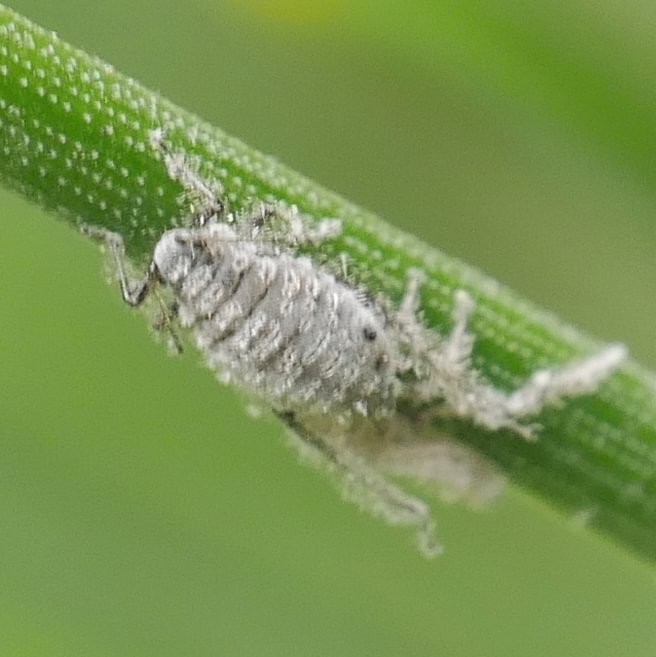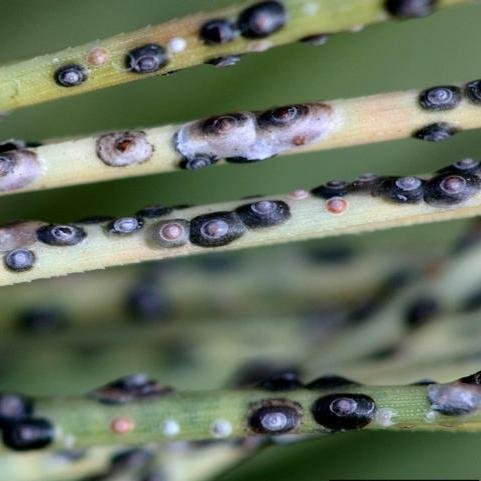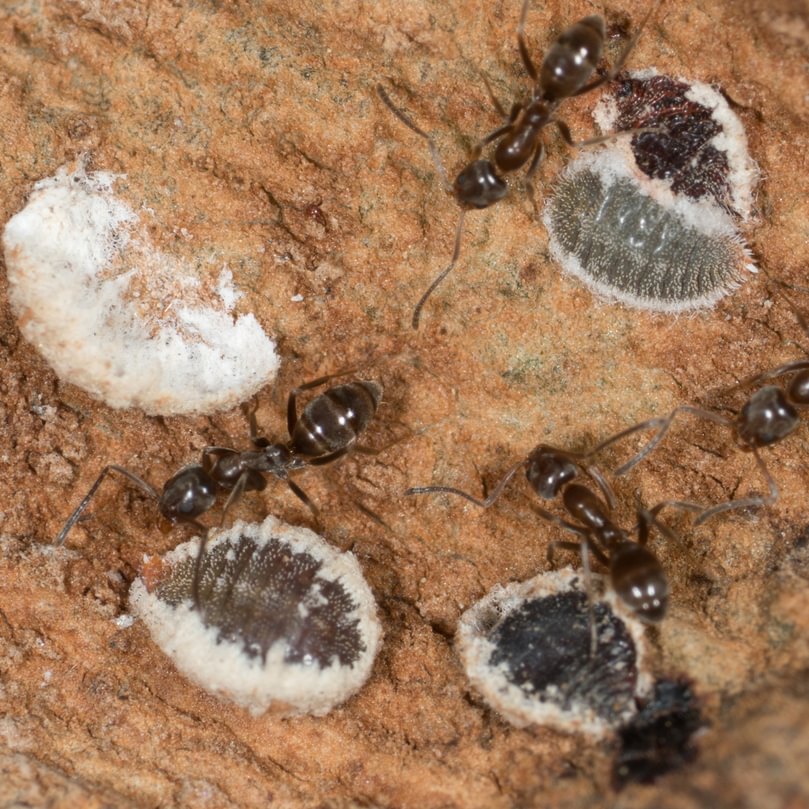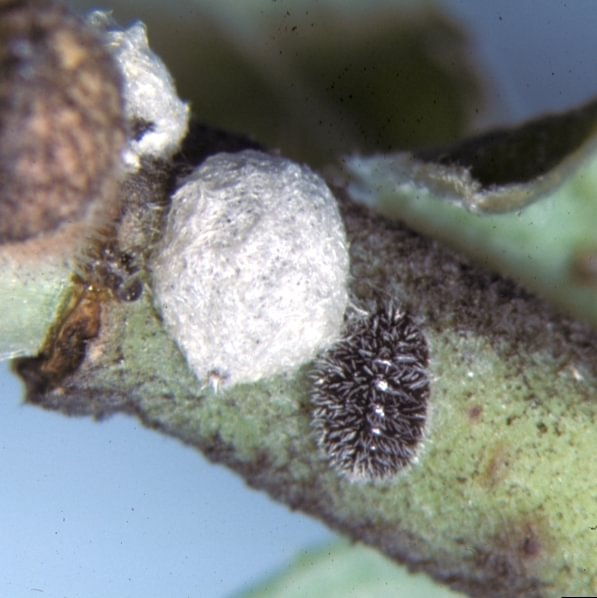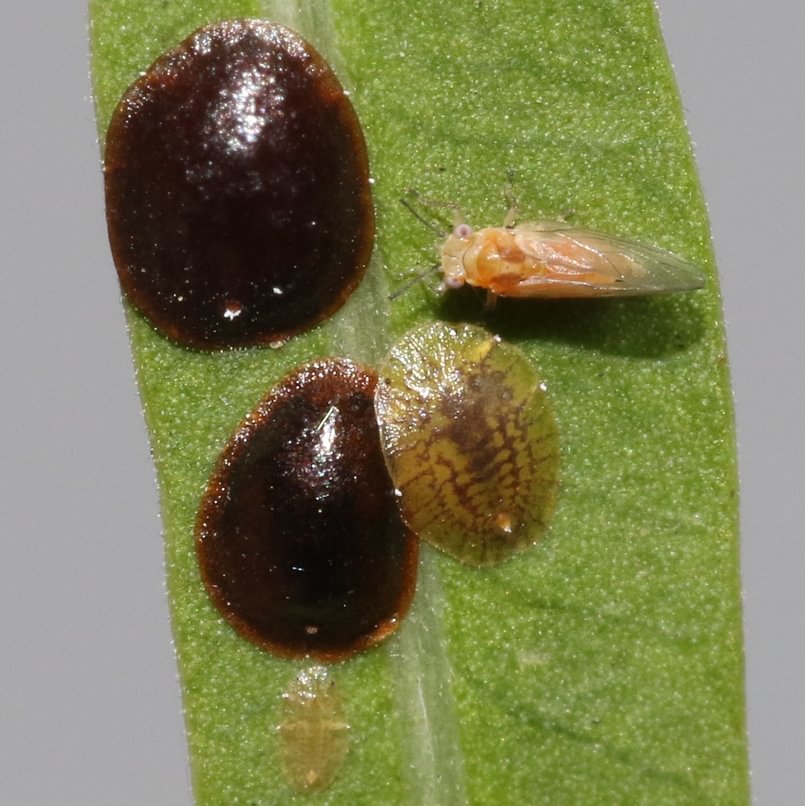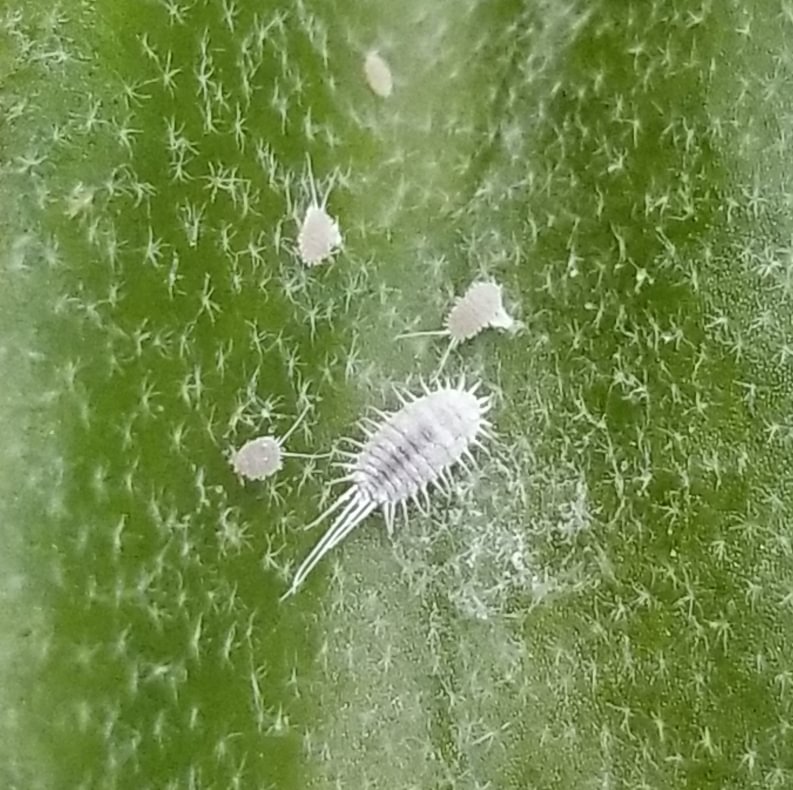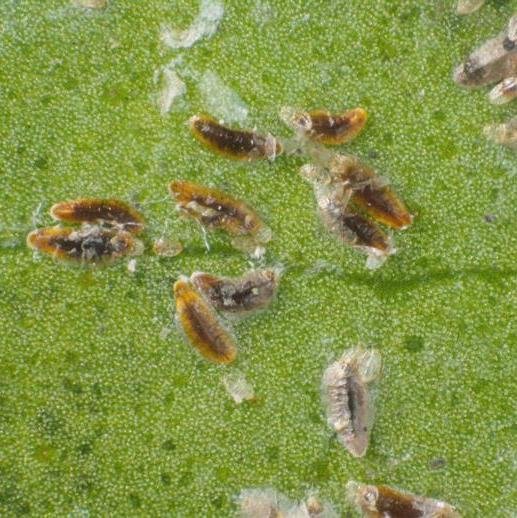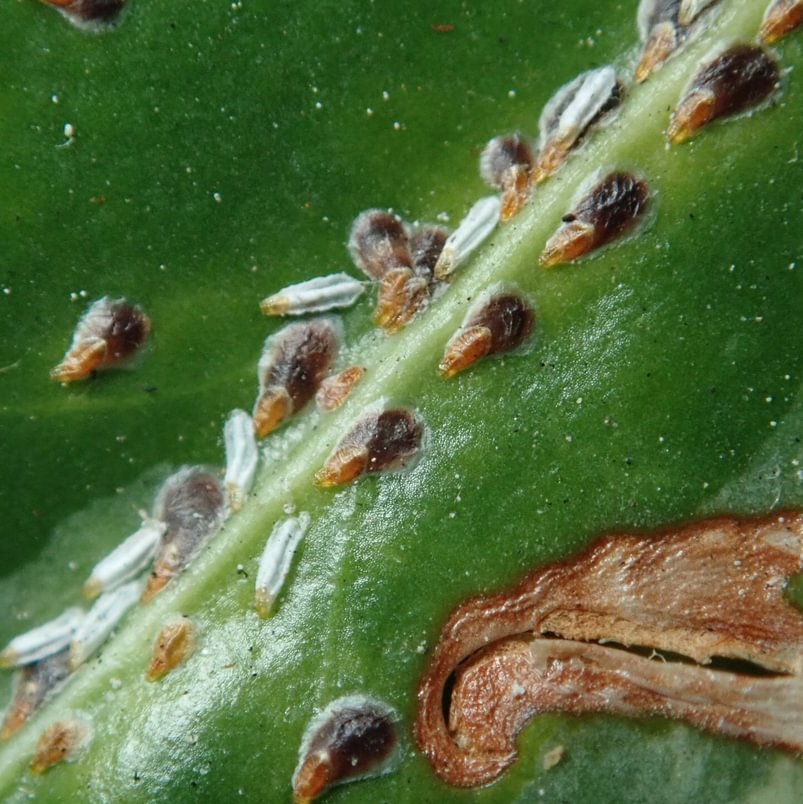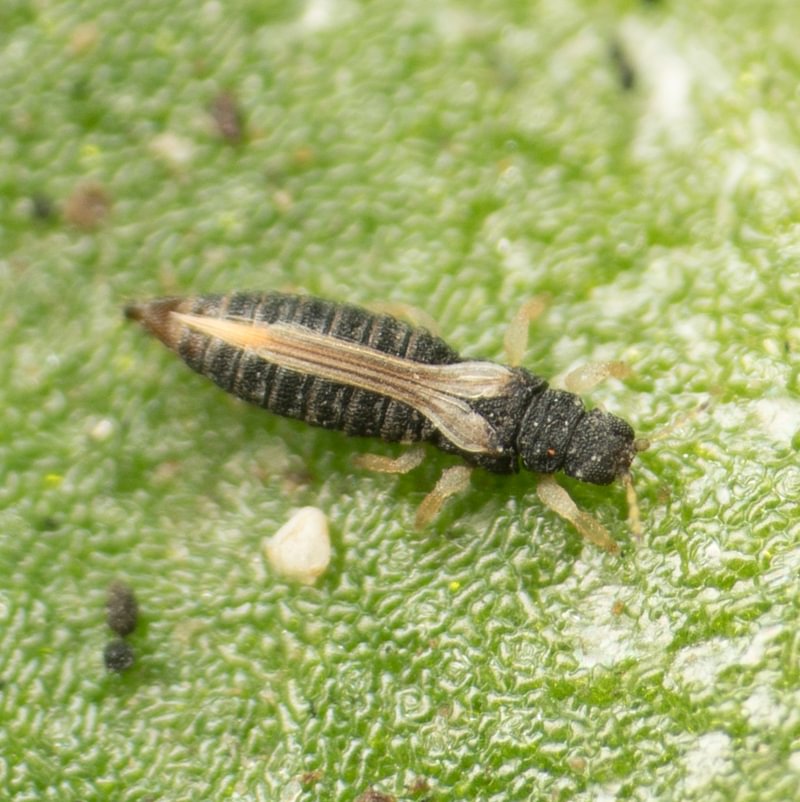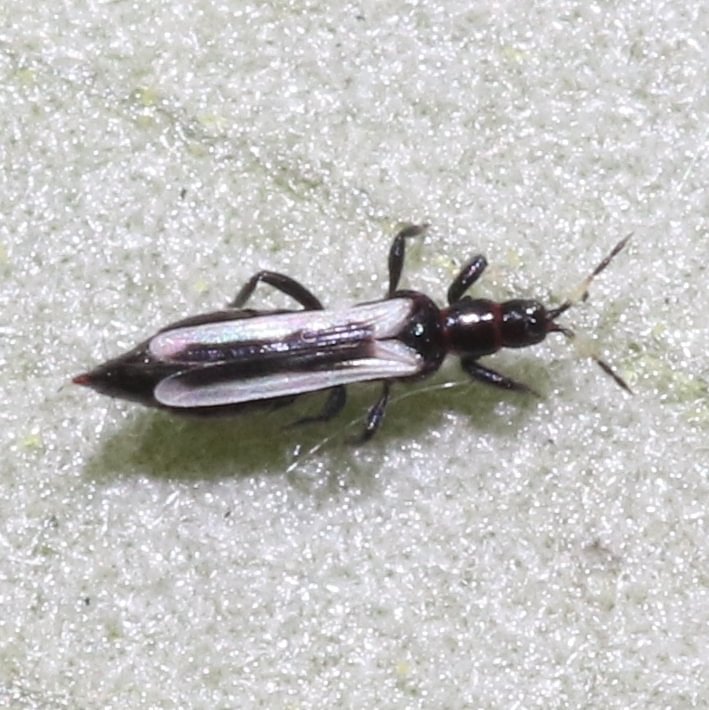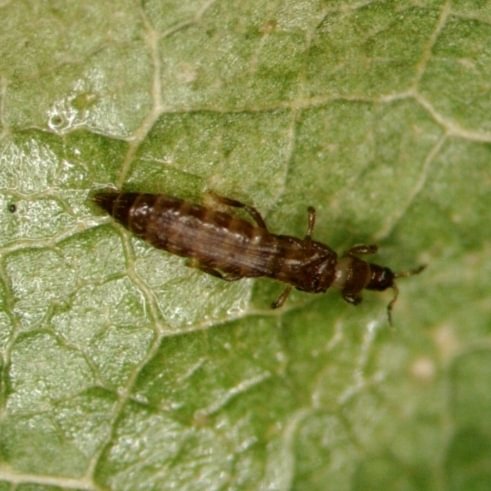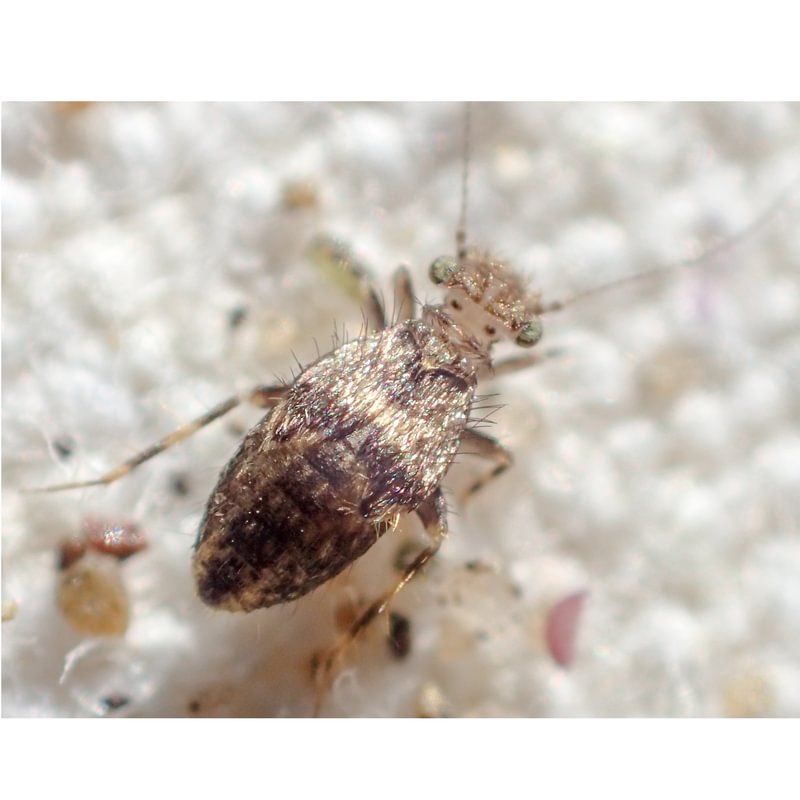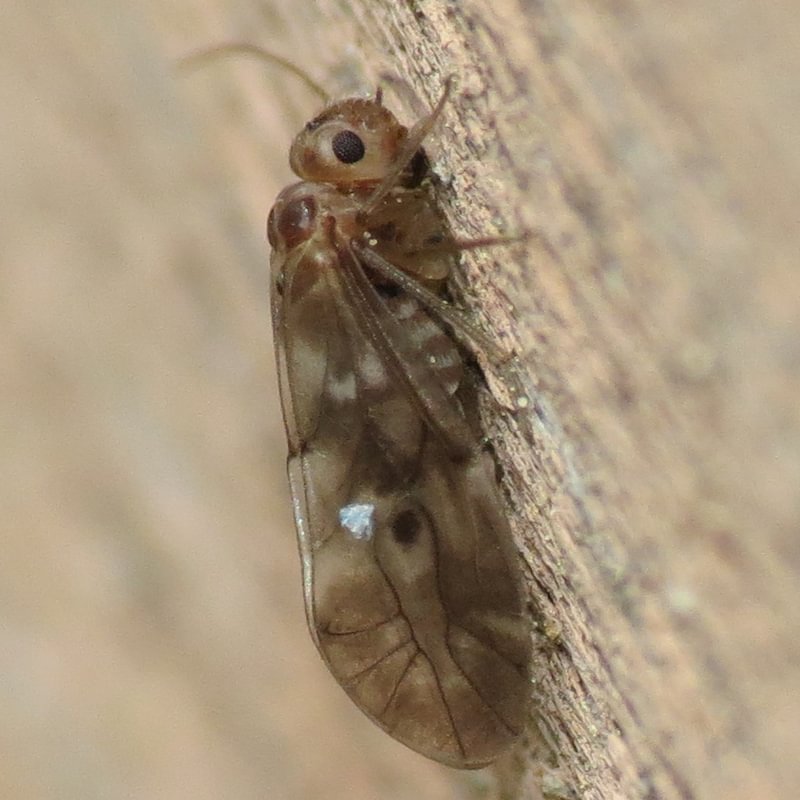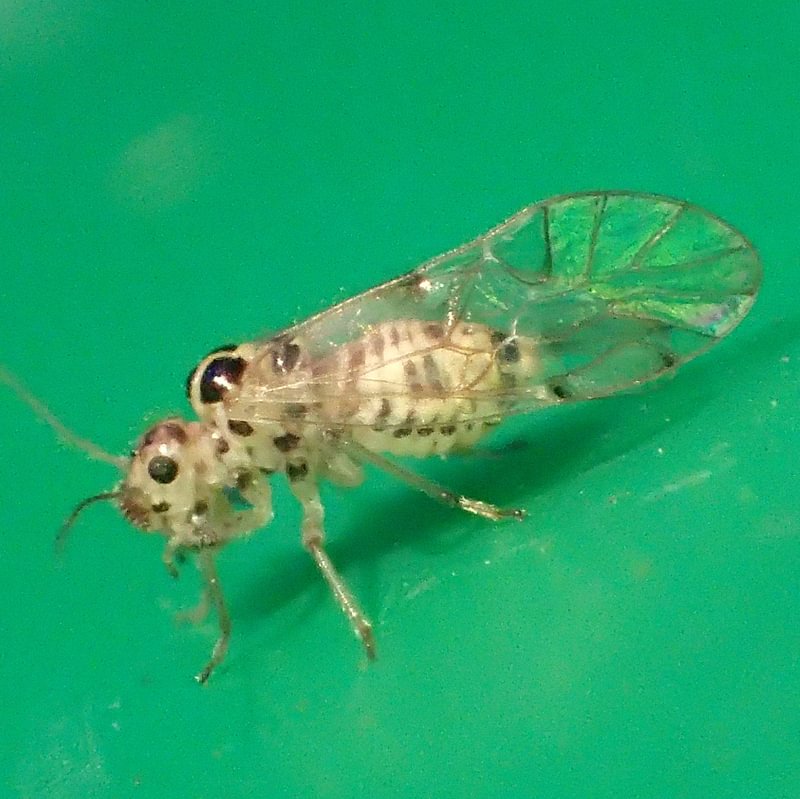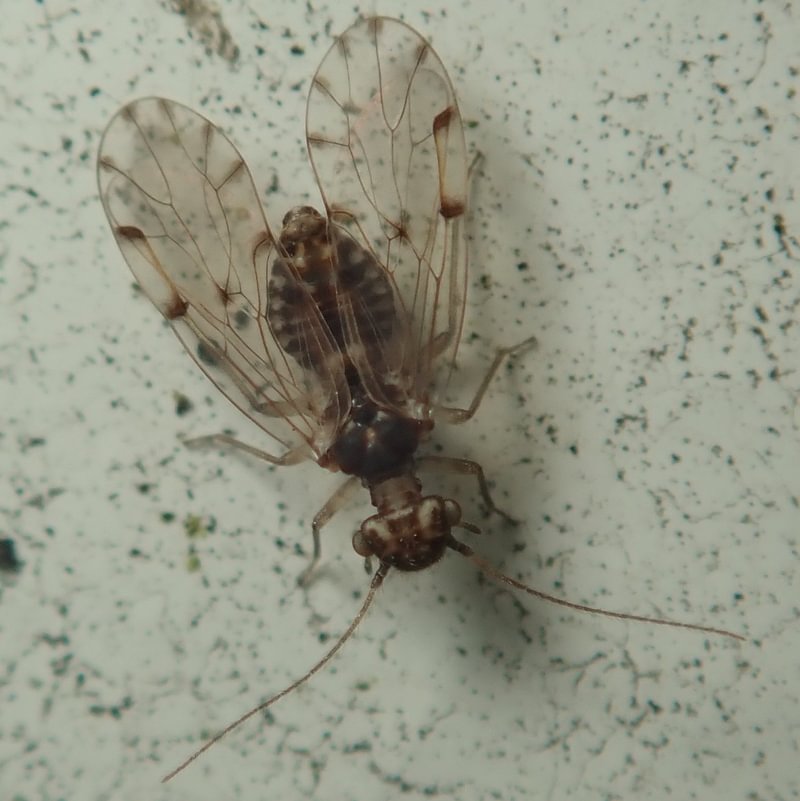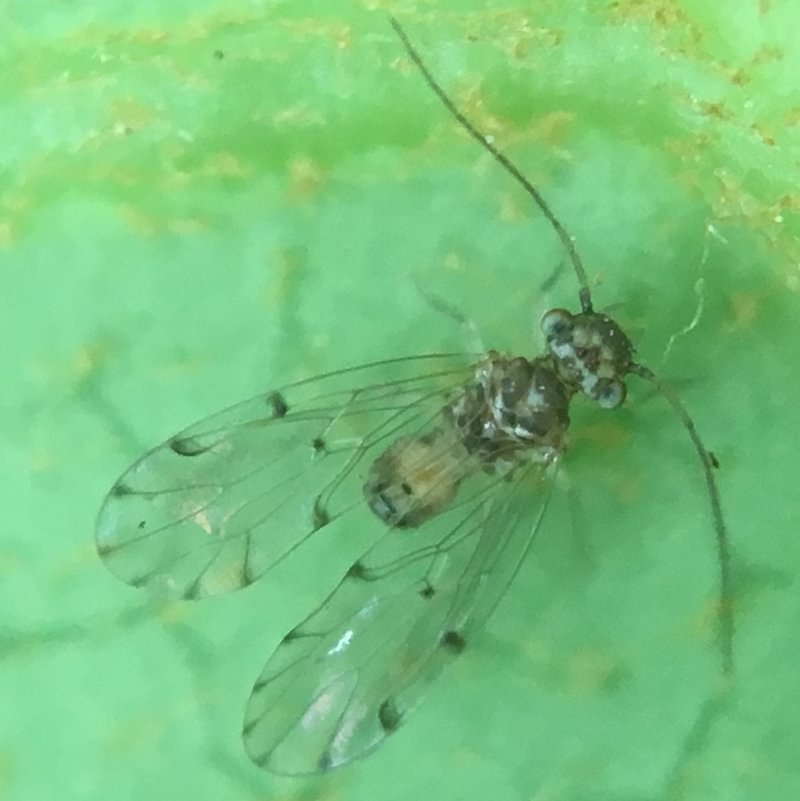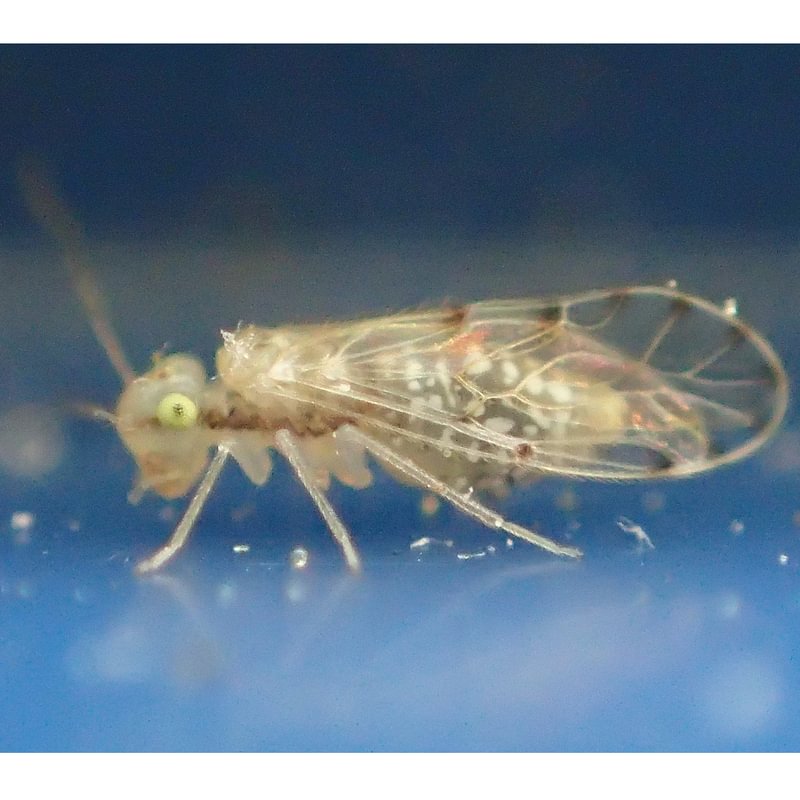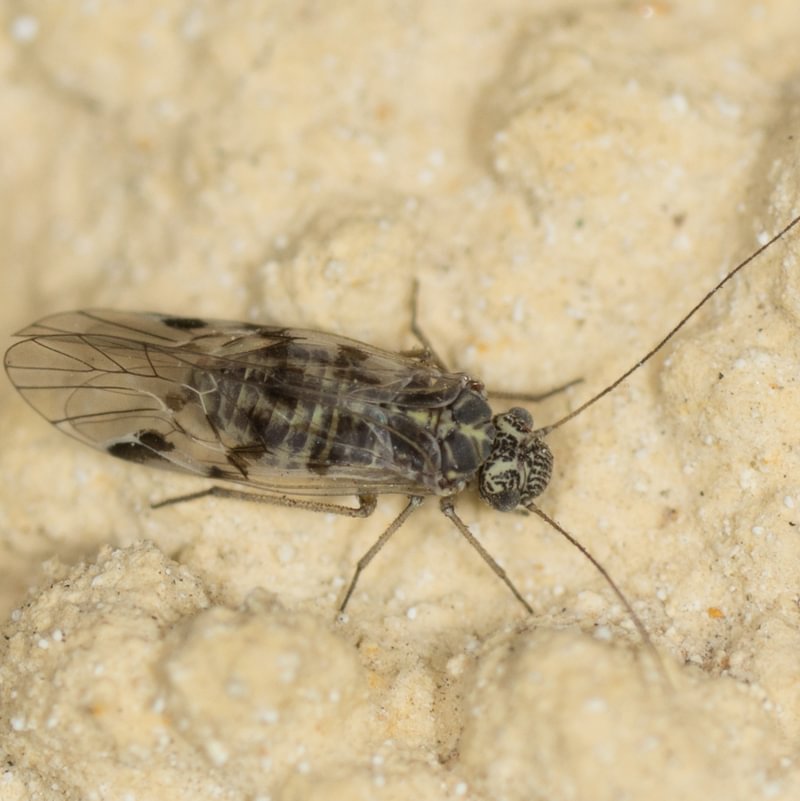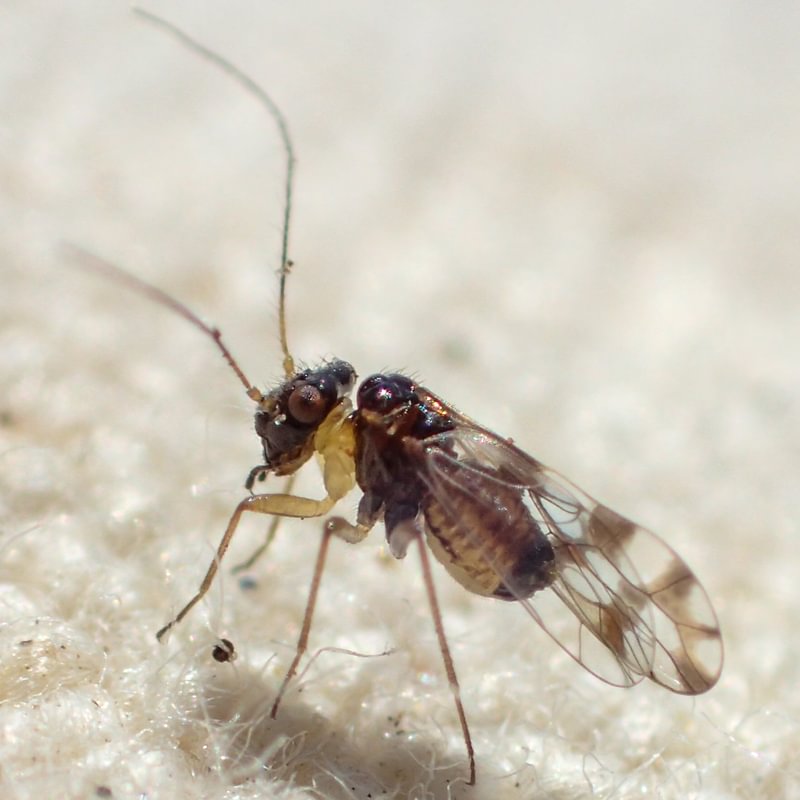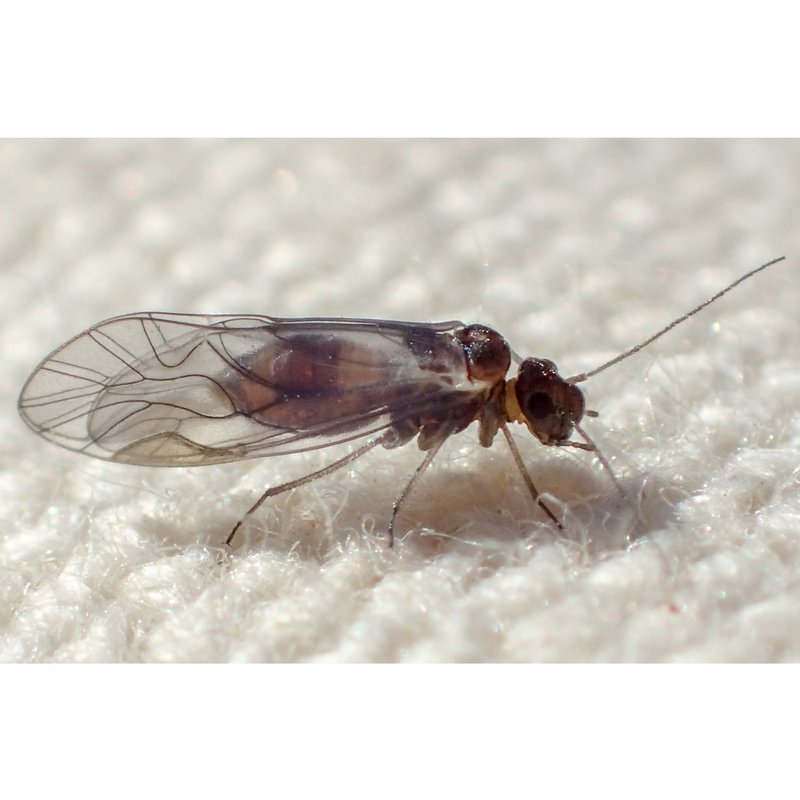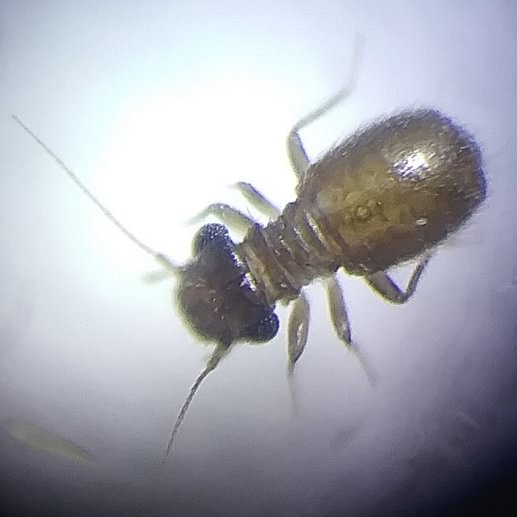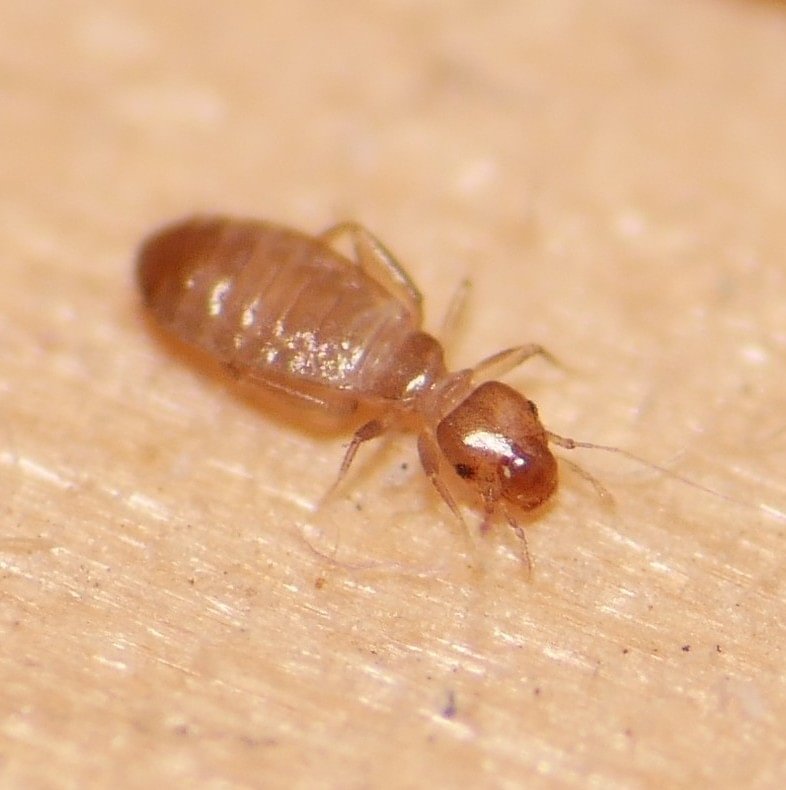Aphids and Scale Insects are true bugs which feed on the sap of plants and trees. Thrips and Barklice are primitive insect families considered either part of the True Bugs or closely related to them. All of these insects are small and often found congregating on plants in large numbers.
Aphids (Aphidoidea Aphids are small insects with soft bodies that feed in large groups on plant juices. They are most closely related to “spruce aphids” and then scale insects. Some aphids feed on the same plant all year round while others spend the summer on one type of plant and the winter on another.
The aphids here are roughly organized by the plants they’re found on, which is the best way to ID them. Identification can best be done using the aphids page at Influential Points and Aphids on the World’s Plants .
Mottled Arum Aphid (Neomyzus circumflexum ) – To 0.1″. Pale yellow to bright green with broken crossbands in front and a blotch on abdomen. Found on numerous plants including lilies, camellia, and chrysanthemums. (photo © John Bebbington )
Brown Ambrosia Aphid ( Uroleucon ambrosiae ) – 0.1″-0.14″. Brown to reddish-brown or dull red with black spikes. Feed on ambrosia, aster, fireweed, sowthistle, goldenrod, and lettuce. (photo © Jesse Rorabaugh )
Foxglove Aphid (Aulacorthum solani ) Mihajlo )
Rose Aphid (Macrosiphum rosae ) – 0.07:-0.14″. Pink to reddish-brown or green with long black spikes and a pale tail. Moves from roses to holly, beans, or wild teasel. Introduced from Europe. (photo © giantcicada )
Rose-Grain Aphid (Metopolophium dirhodum Jesse Rorabaugh )
Potato Aphid (Macrosiphum euphorbiae ) James Bailey )
Shallot Aphid (Myzus ascalonicus – to 0.09″. Shiny green of various shades or even yellow with brown antennae and legs. Found on numerous crops including onion, broccoli, pumpkin, strawberry, and tulip. (photo © Influential Points )
Black Bean Aphid (Aphis fabae ) – To 0.12″. Green-brown to black with plump body. Yellow eyes/antennae. Feeds on beans, potato, tomato, sunflower, and numerous other plants. Winters on shrubs. Introduced from Europe. (photo © Alexis )
Pea Aphid (Acyrthosiphon pisum ) Felix Riegel )
Poplar Petiole Gall Aphid (Pemphigus populitransversus Joanne Redwood )
Willow-Umbellifer Aphid (Cavariella pastinacae Influential Points )
Willow-Carrot Aphid (Cavariella aegopodii – 0.06″-0.11″. Green or reddish, with yellow spikes and legs. Moves from willows to carrots, celery, parsnip, fennel, and related plants. Introduced from Europe. (photo © Jesse Rorabaugh )
Small Willow Aphid (Aphis farinosa ) James Bailey )
Giant Willow Aphid (Tuberolachnus salignus ) Kasper Malmberg )
Black Willow Bark Aphid ( Pterocomma salicis ) – To 0.18″. Black with numerous white spots in distinct rows. Orange legs and spikes. Found on willow twigs. Introduced from Europe. (photo © Nathanial Sharp )
Bead-like Cottonwood Gall Aphid ( Thecabius populimonilis ) – To 0.12″. This waxy yellowish-olive aphid hides in small round reddish-green galls. Moves between the leaves of cottonwood and the roots of willow. (photo © Sawyer Baran )
Rosebay Willowherb Aphid ( Aphis salicariae ) – To 0.1″. Reddish-brown to gray dusted with wax, small dark spikes in back. Moves between dogwood and willowherb. Introduced from Europe. (photo © InfluentialPoints )
Wooly Beech Aphid (Phyllaphis fagi ) Felix Riegel )
California Maple Aphid ( Periphyllus californiensis ) – 0.08″-1.2″. Reddish-brown to olive-green with black crossbands. Found on maple trees. (photo © Marie Lou Legrand )
Small Walnut Aphid (Chromaphis juglandicola Influential Points )
Dusky-veined Walnut Aphid (Panaphis juglandis – 0.14-0.17″. Yellow with dark blotches on nymphs becoming black bands on adults. Found on English Walnut. Introduced from Europe. (photo © bersou )
Black Citrus Aphid (Toxoptera aurantii ) – To 0.08″. Reddish-brown to black with banded antennae. Often on citrus but here found on figs, sumac, and camellias. (photo © Influential Points )
Green Apple Aphid (Aphis pomi ) Paul Bowyer )
Spiraea Aphid (Aphis spiraecola ) – To 0.09″. Greenish-yellow to bright green with dark spikes in back. Moves between fruit trees and shrubs. (photo © Jesse Rorabaugh )
Hop Aphid (Phorodon humuli – 0.04-0.1″. Pale yellow-green with three dark green stripes. Two long spikes in the back. Moves between plum trees and hops. Introduced from Europe. (photo © alderash )
Mealy Plum Aphid (Hyalopterus pruni – 0.06″-0.1″. Slender aphid, pale green or red with darker mottling and waxy covering. Moves from stonefruits (plum, peach, apricot, cherry) to reed grasses. Introduced from Mediterranean. (photo © Marie Lou Legrand )
Leaf-curling Plum Aphid ( Brachycaudus helichrysi ) – To 0.08″. White, yellow, green, or pink with slight wax. Causes leaves to roll up tightly. Moves from stonefruits to flowers like goldenrod, aster, and chrysanthemum. (photo © Alexis )
Short-beaked Clover Aphid (Nearctaphis bakeri Influential Points )
Plum-thistle Aphid (Brachycaudus cardui ) Rolf Lawrenz )
Water Lily Aphid (Rhopalosiphum nymphaeae – To 0.11″. Reticulated reddish-brown to olive. Moves from stonefruits to semi-aquatic plants, sometimes even going in water. Introduced from Europe. (photo © Cedric Lee )
Black Cherry Aphid (Myzus cerasi alderash )
Bird Cherry-Oat Aphid (Rhopalosiphum padi ) Jesse Rorabough )
Green Peach Aphid (Myzus persicae ) – To 0.09″. Yellowish-green, sometimes green or pink. Moves from stonefruits to almost any vegetable or flower. Introduced from Asia. Considered a major pest. (photo © Jesse Rorabaugh )
Ornate Aphid ( Myzus ornatus ) 0.04″-0.07″. Dirty yellowish-green with dark green or brown markings. Found on cherry trees, chrysanthemum, violets, pansies, and several weeds. (photo © Influential Points )
Serviceberry Aphid ( Nearctaphis sensoriata ) to 0.09″. Reddish-brown to blackish. Found on serviceberry and sometimes mountain ash. (photo © Andy Jensen )
Snowberry Aphid ( Aphthargelia symphoricarpi ) – To 0.11″. Dark blue, dusty green, or black with white crossbands. Found on snowberry. (photo © Jason Headley )
Strawberry Aphid (Hayhurstia atriplicis – 0.04″-0.07″. Translucent yellow to greenish-yellow with long spikes. Found on wild and cultivated strawberry, as well as wild rose and sweetbriar rose. (photo © Influential Points )
Elder Aphid (Aphis pomi ) Else Mikkelsen )
Spindly Elderberry Aphid (Macrosiphum stanleyi Andy Jensen )
Large American Raspberry Aphid ( Amphorophora agathonica ) – To 0.19″. Pale green with brown legs. Antennae darken towards ends. Feed on raspberry bushes. (photo © Stephen Ausmus, USDA )
Salmonberry Aphid (Amphorophora forbesi Andy Jensen )
Blackberry-grass Aphid (Tuberolachnus salignus ) Kasper Malmberg )
Blackcurrant-Sowthistle Aphid (Hyperomyzus lactucae Influential Points )
Redcurrant Blister Aphid ( Cryptomyzus ribis ) – 0.06″-0.09″. Whitish, yellow, or pale green with green middorsal stripe. Causes redcurrant and other currant leaves to blister red. Introduced from Europe. (photo © Nikita Gerasin )
Dogberry Aphid (Nasonovia cynosbati – 0.07-0.12″. Pale green, sometimes suffused with dark green or red. Found on currants, piggyback plant, and fringecups. (photo © Influential Points )
Serviceberry Aphid ( Nearctaphis sensoriata ) to 0.09″. Reddish-brown to blackish. Found on serviceberry and sometimes mountain ash. (photo © Andy Jensen )
Short-beaked Clover Aphid (Nearctaphis bakeri Influential Points )
Dogberry Aphid (Nasonovia cynosbati – 0.07-0.12″. Pale green, sometimes sufficed with dark green or red. Found on currents, piggyback plant, and fringecups. (photo © Influential Points )
Hazel Aphid ( Myzocallis coryli ) 0.05″-0.09″. Pale yellow, sometimes to the point of almost white, and covered in tiny hairs. Found on the leaves of hazel. (photo © Sandy Rae )
Wild Legume Aphid ( Macrosiphum creelii ) 0.09″-0.16″. A large pale green to yellow aphid with long slender spikes. Found on wild legumes such as vetches and peavines. (photo © Andy Jensen )
Dock Aphid (Aphis rumicis ) – To 0.11″. Dark greenish-brown to dull black with spines in back. Found on docks and sorrels, sometimes rhubarb. (photo © Felix Riegel )
California Lilac Aphid (Aphis ceanothi ) – To 0.09″. Reddish to brown with black end that has two spikes protruding from it. Found on California Lilacs. (photo © dlbowls )
Pearly Everlasting Aphid ( Uroleucon russellae ) – To 0.13″. Rust-colored with bronzy-black. Has extremely long legs. Found on pearly everlasting and cudweed. (photo © Influential Points )
Northwest Saxifrage Aphid ( Macrosiphum tolmiea ) 0.12″. A bright green aphid with dark spikes. Found in wet forests on small plants including piggyback plants, fringecups, and bishop’s caps. (photo © Andy Jensen )
Wild Legume Aphid ( Macrosiphum creelii ) 0.09″-0.16″. A large pale green to yellow aphid with long slender spikes. Found on wild legumes such as vetches and peavines. (photo © Andy Jensen )
Fennel Aphid (Hyadaphis foeniculi Influential Points )
Wayfaring Tree-Sedge Aphid ( Ceruraphis eriophori ) – 0.1″-0.12″. Reddish-violet when small, deep black in larger form. Moves between viburnum and various sedges. (photo © Influential Points )
Chenopodium Aphid (Hayhurstia atriplicis – 0.06″-0.12″. Green with white wax powder, short yellow spikes. Found on orache and goosefoot, rolling leaves into pseudogalls. Introduced from Europe. (photo © ðejay (Orkney) )
Broom Aphid (Aphis cytisorum sarothamni ) Jan Grathwohl )
Cocksfoot Aphid ( Hyalopteroides humilis ) Influential Points )
Common Dogwood-Grass Aphid (Anoecia corni ) Felix Riegel )
English Grain Aphid (Sitobion avenae ) – To 0.13″. Can be yellowish-green or reddish-brown, both forms with yellow legs. Found on many grains and grasses. Introduced from Europe. (photo © Jesse Rorabough )
American Grass-leaf Aphid (Utamphorophora humboldti ) – To 0.1″. Apple-green with pale green stripe in the middle border in darker green. Moves between ninebark and the leaves of sedges/grasses. (photo © Influential Points )
Buckthorn-Fern Aphid (Macrosiphum rhamni – 0.07″-0.1″. Pale yellow to yellowish-green, with a spot of red pigment under the surface in the middle. Moves between buckthorn and ferns. (photo © Andy Jensen )
Ocean Spray-Fern Aphid (Macrosiphum walkeri Andy Jensen )
Ivy Aphid ( Aphis hederae ) – To 0.1″. Dark brown to dull black with small spikes in back. Primarily found on English Ivy as well as spikenard and schefflera. (photo © Gilles San Martin )
Spruce Aphids (Adelgidae )
“Spruce Aphids”, also known as “Pine Aphids”, differ from true aphids in lacking cornicles or cauda sticking out the back of the body. They feed on the needles and twigs of conifers like spruce or pines. Because at different life stages they have varying appearance and may be covered by a gall or waxy excretion, Spruce Aphids are often ID’d by their effect on plants (drained needles and galls on branches) rather than by seeing the bug itself.
Douglas Fir Adelgid (Adelges cooleyi ) – To 0.1″. Dark brownish, often with waxy cotton covering. Sucks juice from Douglas Fir needles and forms galls on spruce twigs. Also known as “Cooley Spruce Gall Adelgid”. (photo © Noah Strycker )
Pineapple-gall Adelgid (Adelges abietis – Bugs themselves are yellowish-brown but usually identified by the pineapple-like galls they form on Norway and Sitka Spruce. Introduced from Europe. (photo © Robby Deans )
Hemlock Wooly Adelgid (Adelges tsugae thylacine )
Waxy Gray Pine-leaf Aphid (Schizolachnus pineti – To 0.1″, smaller than Cinara sp . Brown to grayish-green with waxy coating. Found on the needles of pine trees. Introduced from Europe. (photo © Joe Holt )
Scale Insects (Coccoidea
Also called “mealy bugs”, the females of this species are soft limbless bugs that hide under a protective scale on their plant host. They often remain unnoticed until they produce a large eggsac behind or above their actual bodies. Males on the other hand are tiny winged fly-like bugs that can travel between the plants to fertilize the females. Some species have a mutualistic relationship with ants. Identification is often difficult and depends on identifying the host plant.
Pine Needle Scale (Chionaspis pinifoliae – 0.3″. Light reddish-brown body with teardrop-shaped white eggsac. Feeds on pine and occasionally hemlock, spruce, or Douglas-fir, typically on curved interior of needles. (photo © Mews )
Black Pineleaf Scale (Dynaspidiotus californica – 0.08″. Tiny conical scales are brown to blackish with pale edges. Found on the needles of pine, hemlock, spruce and Douglas-fir. (Whitney Cranshaw, Colorado State University )
Cottony Camellia Scale (Pulvinaria floccifera – 0.25″. Small brown body with long oval cottony egg sac that extends behind it. Found on yew, camellia, ivy, rhododendron and other woody plants. (photo © Jesse Rorabaugh )
Cottony Maple Scale (Pulvinaria – 0.13″. A flat brown insect with a rather tall cottony white egg sac. Found on the branches of maple and other woody stems. (photo © Jason Dombroskie )
Cottony Maple Leaf Scale (Pulvinaria acericola – to 0.16″. Brown body with yellow-brown ridge and a cottony white egg sac up to 3x longer than body. Found on the underside of leaves, usually maple or dogwood. (photo © Susan Hewitt )
Apple Mealybug (Phenacoccus aceris – A brown or red oval body with waxy white on top. Eggcase is long and oval. Found on apple and other fruit trees as well as maple. (photo © Beatriz Moisset )
Apple Mussel Scale (Lepidosaphes ulmi – To 0.13″. Brown or gray, elongated and slightly curved scale with hint of ribbing. Found on branches, twigs, and fruit of broadleaf deciduous plants and trees. (photo © Melissa Hutchison )
European Fruit Scale (Parthenolecanium corni – To 0.4″. Brown dome-shaped scale. Found on the wood of elm, plum, apricot, cherry, and other deciduous trees. Introduced from Europe. (photo © Oliver K. Reichl )
Oak Lecanium Scale (Parthenolecanium quercifex – To 0.25″. Shape is a bulbous brown dome. Found on twigs of oak and sometimes sycamore or hickory. (photo © hausbaun )
European Elm Scale (Eriococcus spurius – Flat and oval, gray to brown with strong ribbing and waxy white exterior. Found on elm. Introduced from Europe. (photo © Jesse Rorabaugh )
Azalea Bark Scale (Eriococcus azaleae ) – To 0.13″. Reddish-purple, typically covered with white cottony wax. Oval with imprecise borders. Found on azalea, rhododendron, and blueberries. (US Collection of Scale Insect Photographs )
Brown Soft Scale (Coccus hesperidum – 0.12-0.2″. Flat, yellowish-brown with brown speckling or patterned lines, darkening to fully brown with age. Found on numerous hosts. (photo © James Bailey )
Long-tailed Mealybug (Pseudococcus longispinus ) – To 0.16″. Waxy white oval, surrounded by filaments with two especially long “tails”. Found on ornamental and greenhouse plants. (photo © jbarclay )
Fern Scale (Pinnaspis aspidistrae – To 0.1″. Females brown with lighter edges and slightly curved, males straight and whitish. Found in greenhouse on ficus, hibiscus, citrus, magnolia, liriope, and acacia. (photo © John A. Davidson )
Euonymus Scale (Unaspis euonymi – To 0.1″. Dark brown mussel-shaped females and white elongated males. Found on leaves and stems of Euonymus and other ornamental plants. Introduced. (photo © Sequoia Wrens )
Thrips (Thysanoptera
Extremely small, slender, soft-bodied bugs, often with thin fringed wings that they rarely use. Have sucking mouthparts that most species use to suck plant juices, though a few are predators. Larva are often brightly colored while adults are drab and dark. Thrips are difficult to find information on – there are dozens if not hundreds of species in oregon, but only a few of the most well-known ones are covereed here.
Greenhouse Thrips (Heliothrips haemorrhoidalis ) – 0.05″-0.07″. Yellowish/whitish larvae, black adults with pale legs and wings. Found on citrus and other greenhouse plants. Introduced from South America. (photo © Jesse Rorabaugh )
Common Banded Thrips (Aeolothrips fasciatus – To 0.1″. Dark brown body and distinct black-and-white banded wings. Found on flowers where it hunts the larvae of other thrips. Introduced from Europe. (photo © Jesse Rorabaugh )
Rear-bordered Banded Thrips (Aeolothrips kuwanaii ) – Dark brown body, white wings with dark margin on rear (middle when folded). Found on flowering shrubs where it hunts the larvae of other thrips. (photo © James Bailey )
Western Flower Thrips (Frankliniella occidentalis ) – 0.04″-0.06″. Yellowish-white to brown with narrow wings. Feeds on numerous flowers, crops, and fruit trees of many types. (photo © Jesse Rorabaugh )
Pear Thrips (Taeniothrips inconsequens – 0.05″-0.06″. Brown body, narrow wings brown in front and pale behind. Feeds on maples and fruit trees. Introduced from Europe. (photo © Pennsylvania DCNR, bugwood.org )
Barklice and Booklice (Psocoptera )
Considered the most primitive of all true bugs, barklice over 250 million years old have been found in the fossil record. They are very small winged bugs (though many drop their wings) with amusingly bulbous eyes. In nature they feed on fungi and algae on trees, though some have become stored grain pests or enjoy the paste on book bindings. They are a close relative of parasitic lice.
Kellogg’s Scaly-winged Barklouse (Pteroxanium kelloggi – to 0.1″. Brownish haired body with dark brown bars, often white speckling. With or without wings. Found in leaf litter as well as on fence posts and tree trunks. (photo © K Schneider )
Mottled Stout Barklouse (Peripsocus subfasciatus ) Harsi Parker )
Ink-drop Shaggy Barklouse (Teliapsocus conterminus ) – To 0.3″. White, grayish, or yellowish with dark ribbing on abdomen and inky black dots on thorax. Fine hairs on front of forewing. Found on trees including birch. (photo © Seymore Gulls )
Brigg’s Flat-winged Barklouse (Ectopsocus briggsi – to 0.08″. Body brownish-orange to brown, head broad, spotted wings broad and held horizontal. Found on dead leaves outdoors or stored food indoors. (photo © Alexis )
California Flat-winged Barklouse (Ectopsocus californicus Rebecca Marshall )
Clear Lash-faced Booklouse (Trichopsocus clarus ) Seymore Gulls )
Intricate Lizard Barklouse (Valenzuela perplexus ) Arthur MacMillan )
Yellow Lizard Barklouse (Valenzuela flavidus – 0.08″-0.1″. Yellow or yellowish-orange, with some dark markings on top of thorax. Found in broad-leafed trees in forest, feeding on the fungus on leaves. (photo © kristobal22 )
Two-striped Barklouse (Amphigerontia bifasciata ) Jesse Rorabaugh )
Fair-phallus Damp Barklouse (Propsocus pulchripennis – 0.1″. A stout dark barklouse, with off-setting clear and smoky sections on the wings. Found in leaf litter and under objects. Introduced from Australia. (photo © K Schneider )
Dark-headed Damp Barklouse (Elipsocus hyalinus – 0.1″-0.14″. Dark head and thorax, dark bands on abdomen, unique veins on wings. Found on leaves of trees. Introduced from Europe. (photo © K Schneider )
F-winged Barklouse (Graphopsocus cruciatus Seymore Gulls )
Reticulate-winged Booklouse (Lepinotus reticulatus ) Elva Paulson )
House Psocid (Liposcelis bostrychophila – 0.04″. Small, tan, and wingless with small eyes. In nature is found in leaf litter and under bark. A major pest of stored grains, also feeds on mold, dead insects, and insect eggs. (photo © Alexis )
Return to Insects guide






